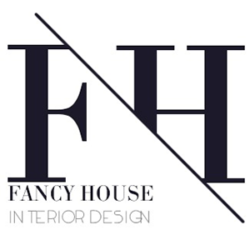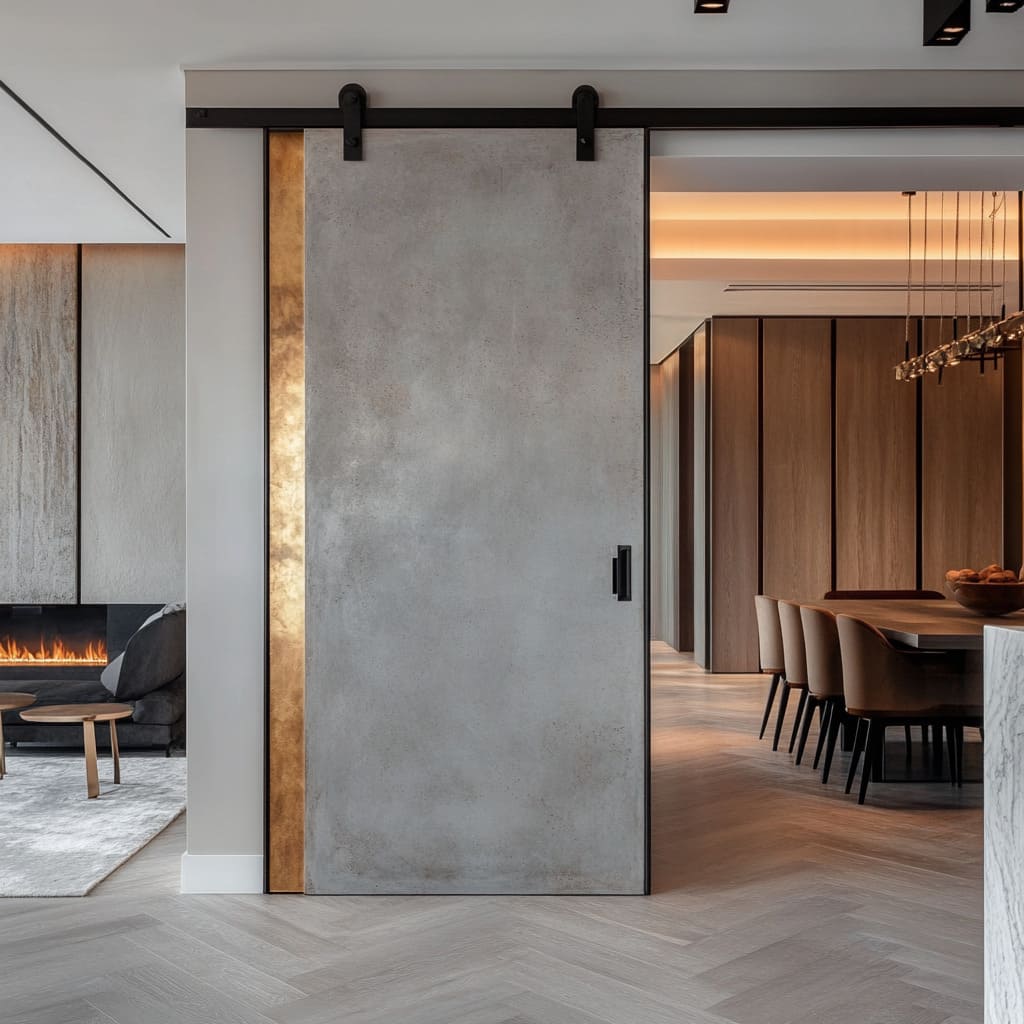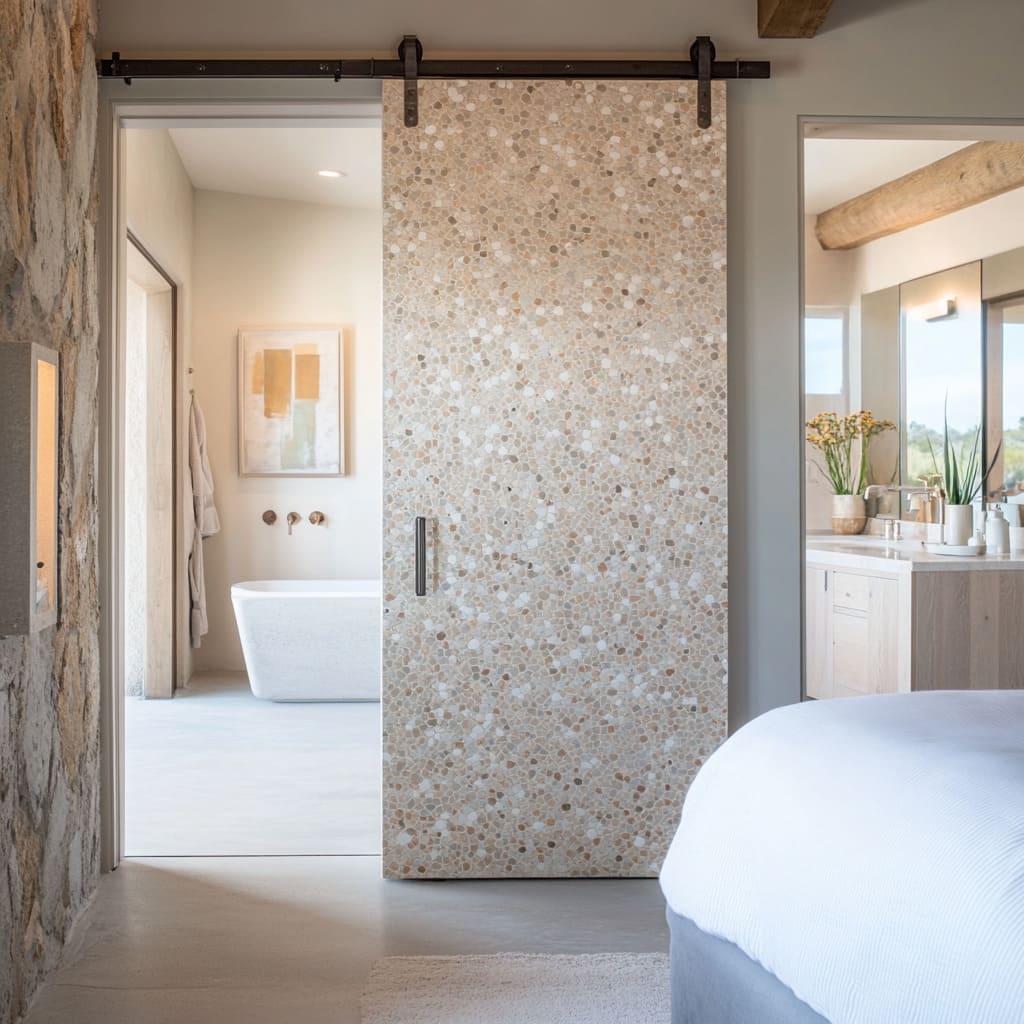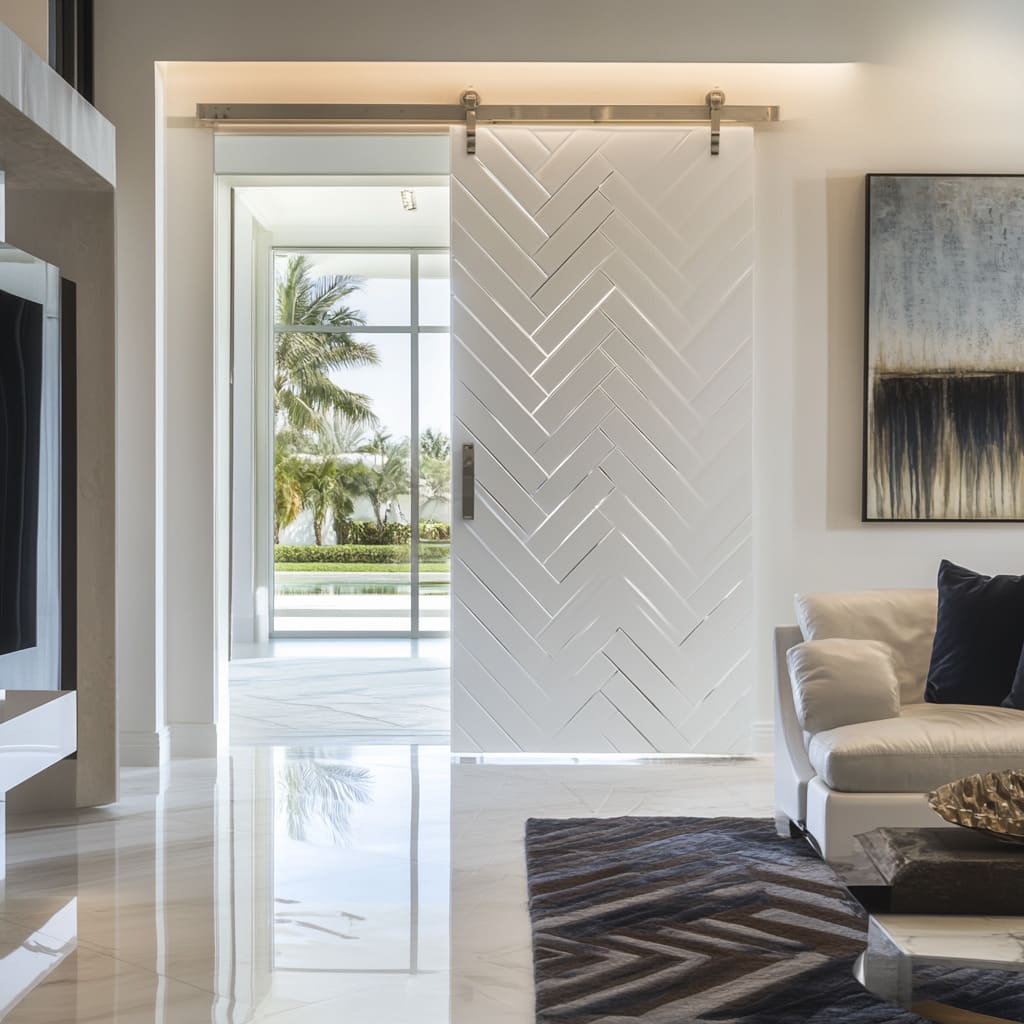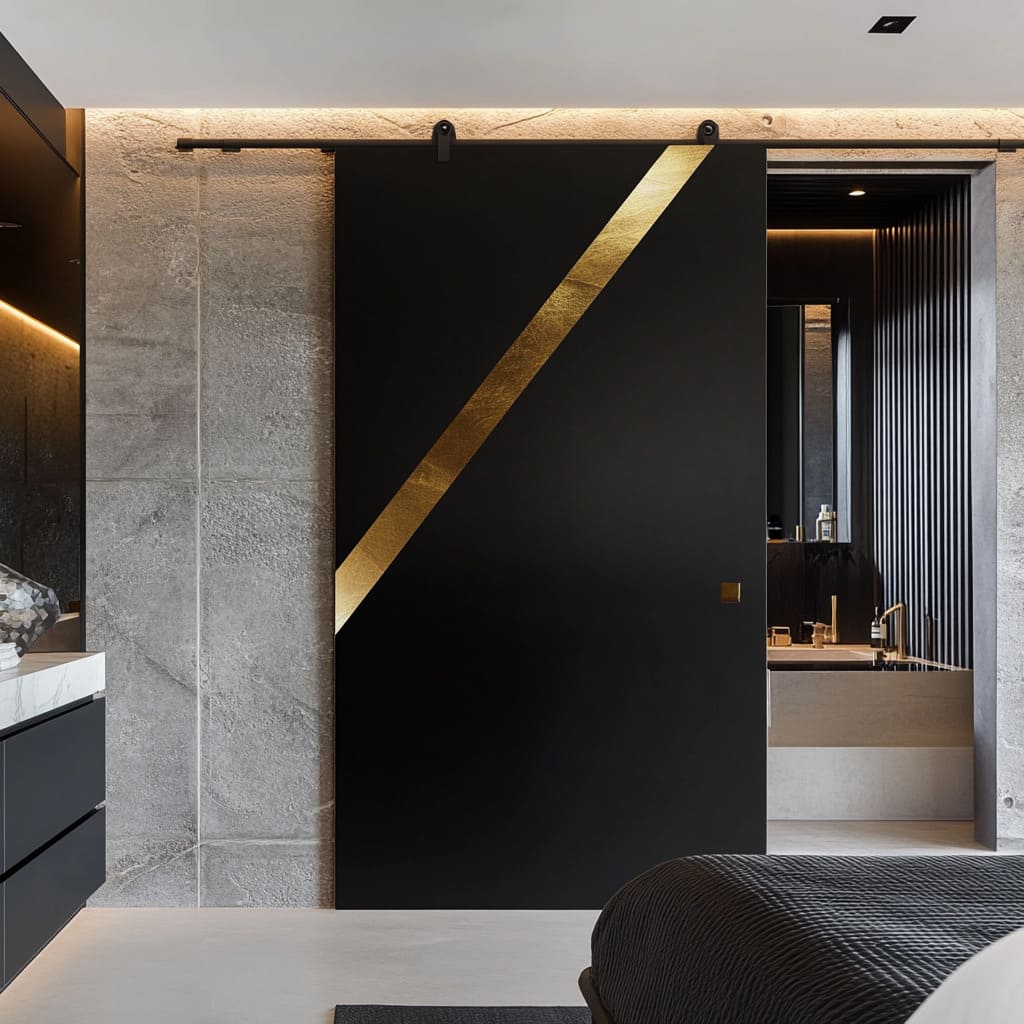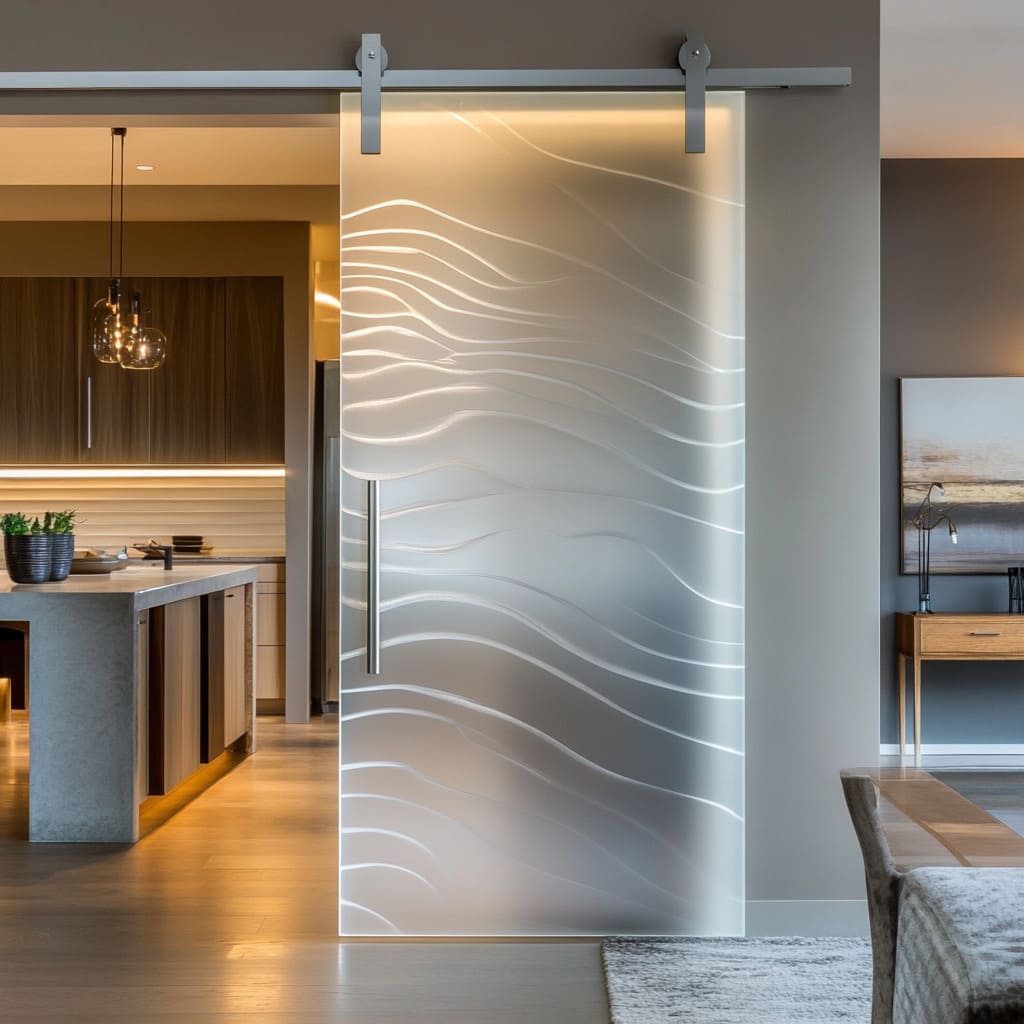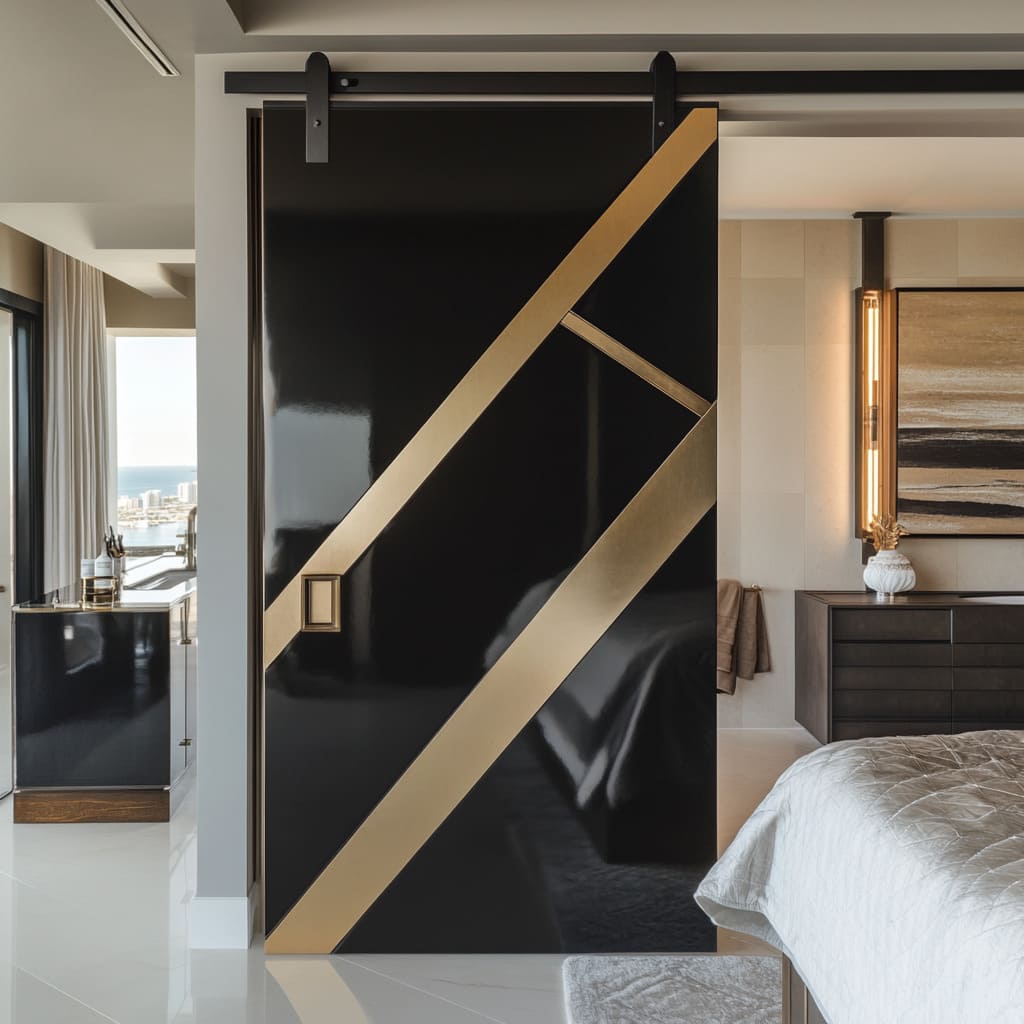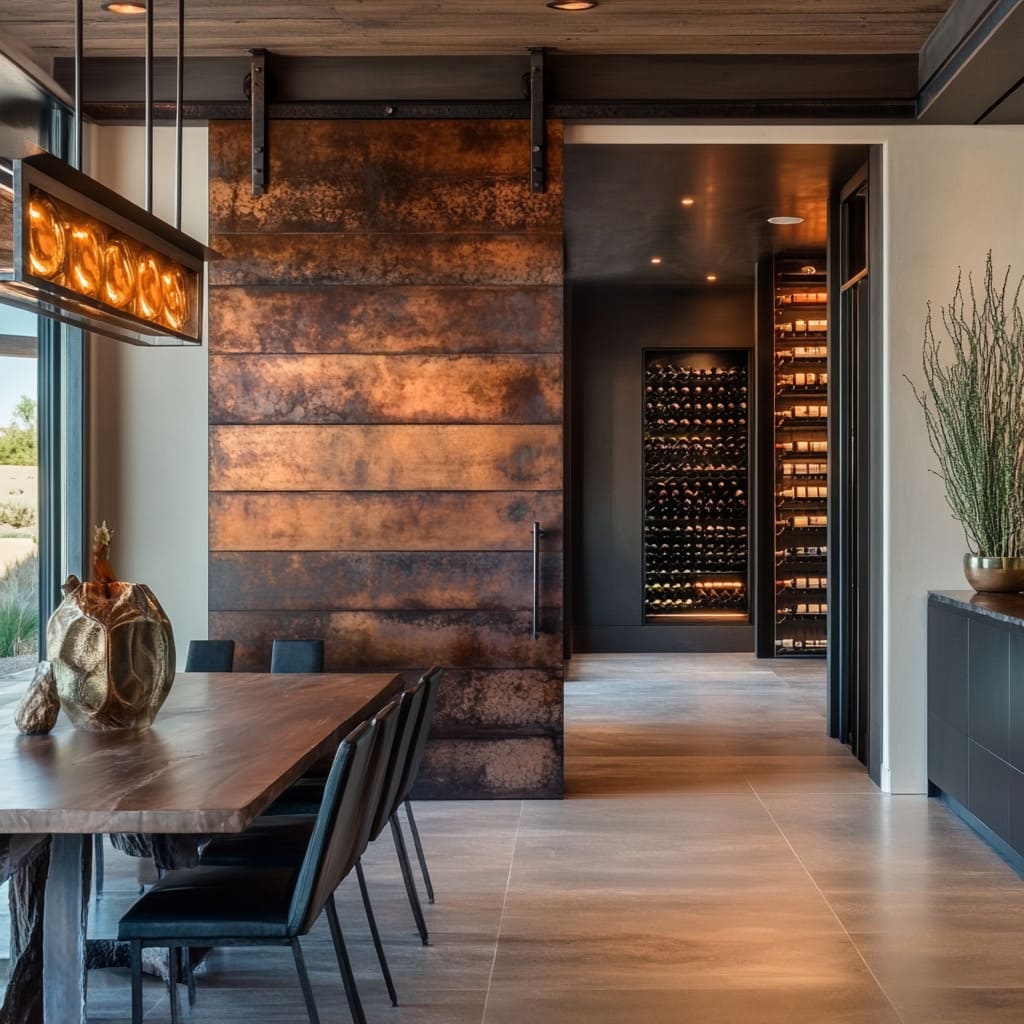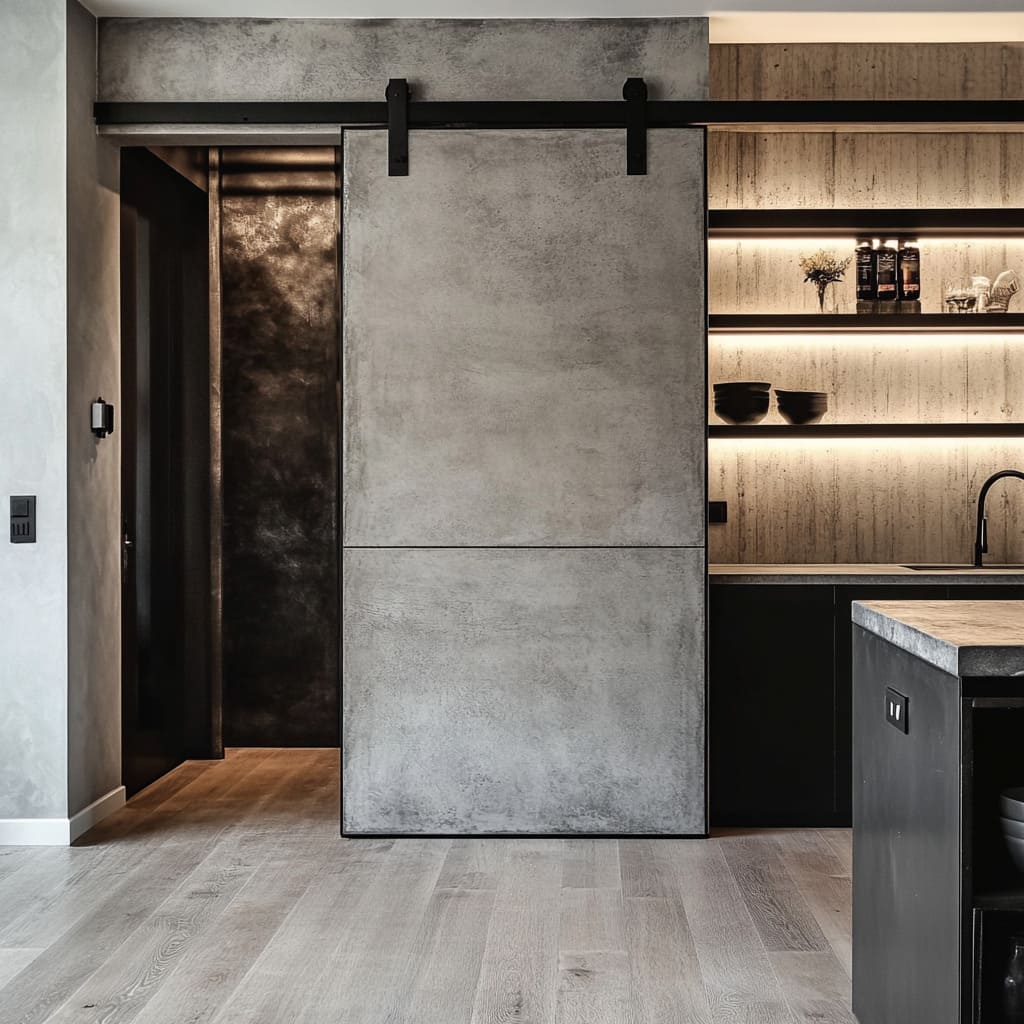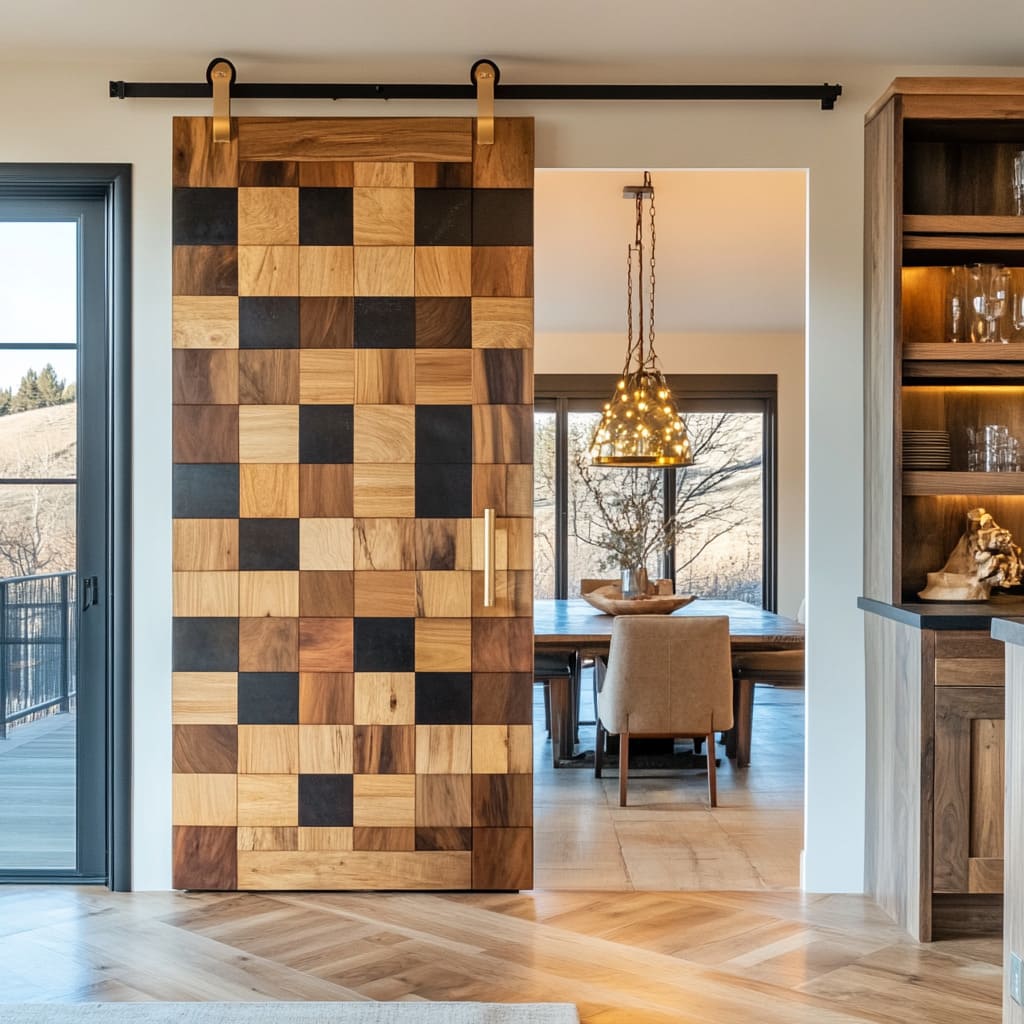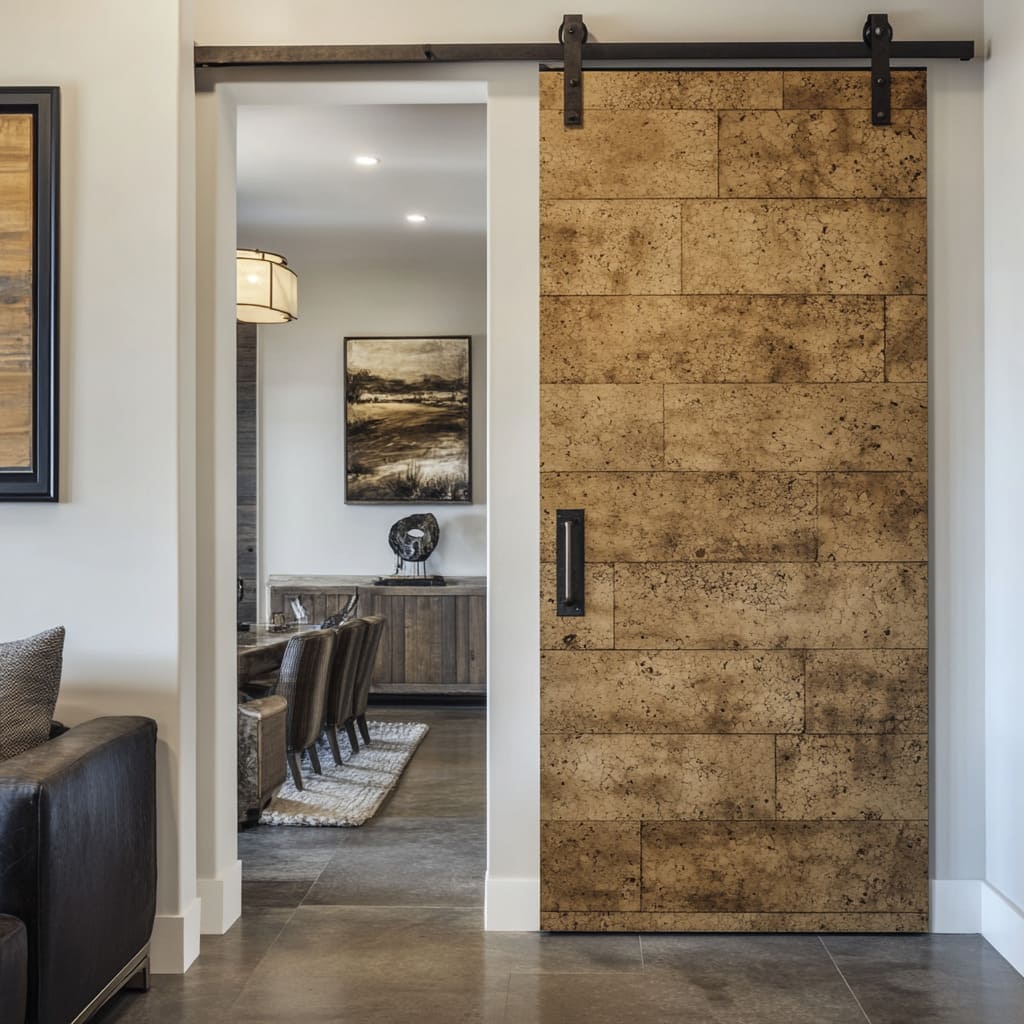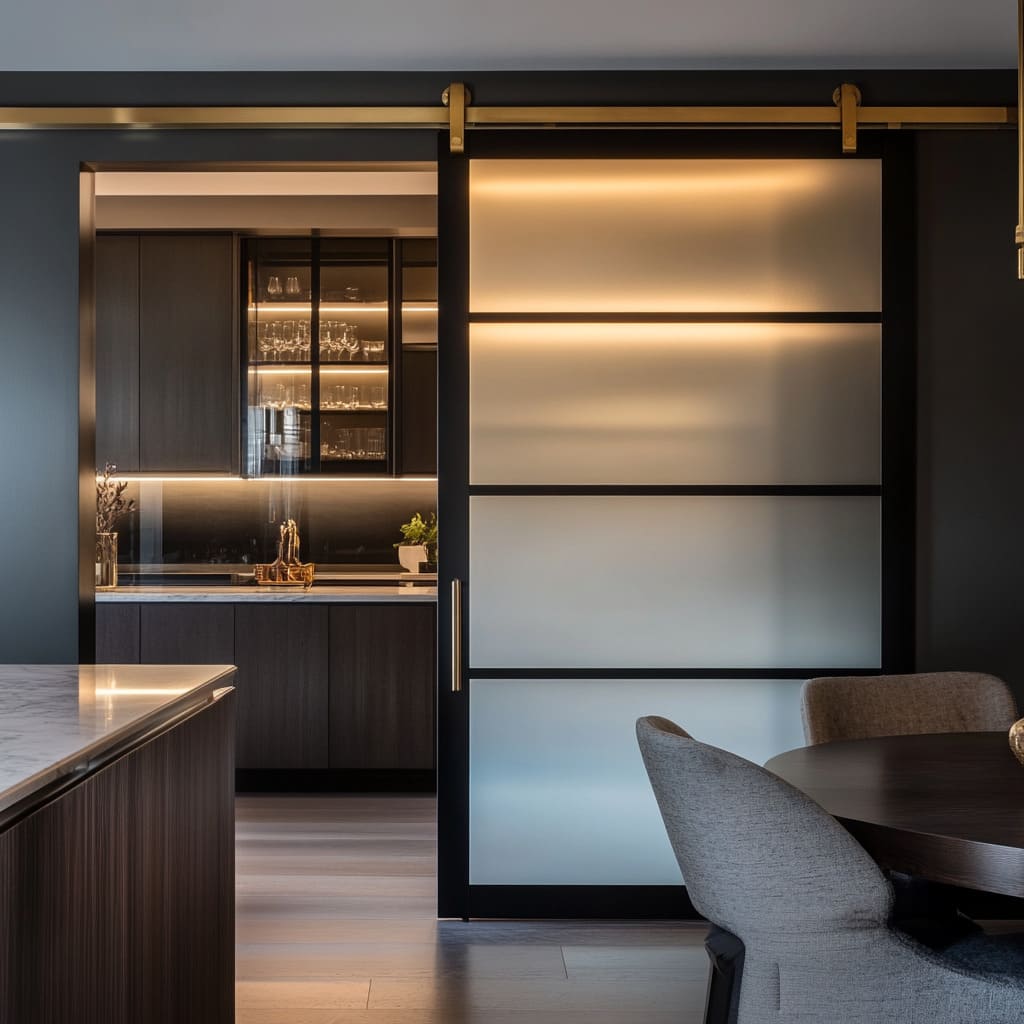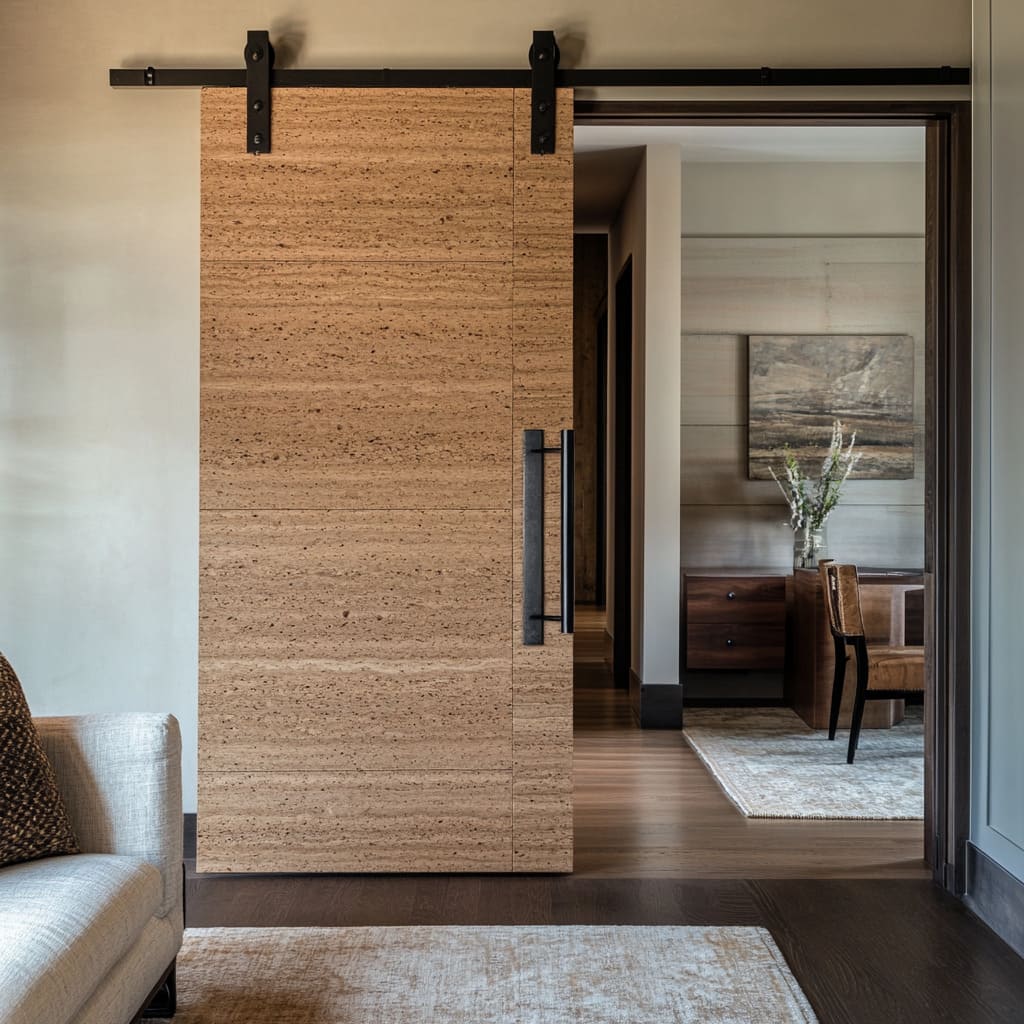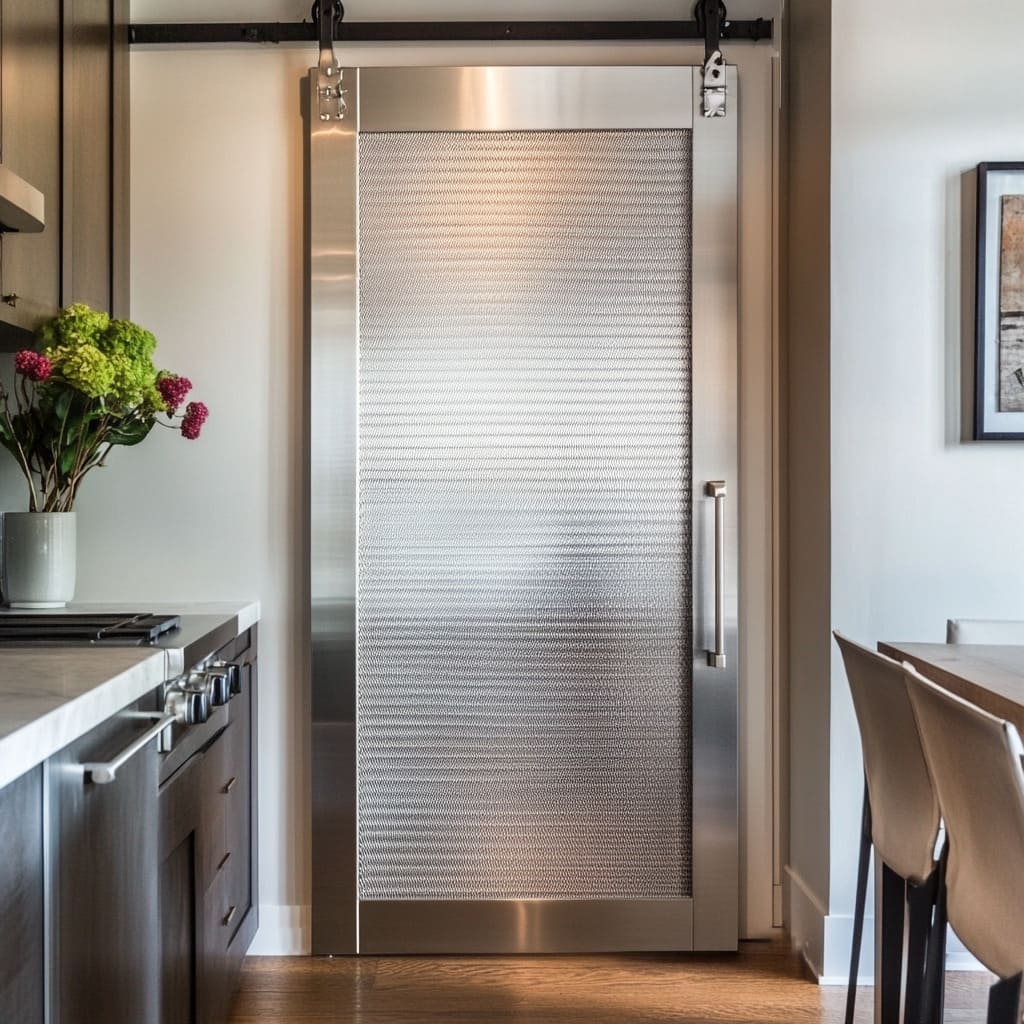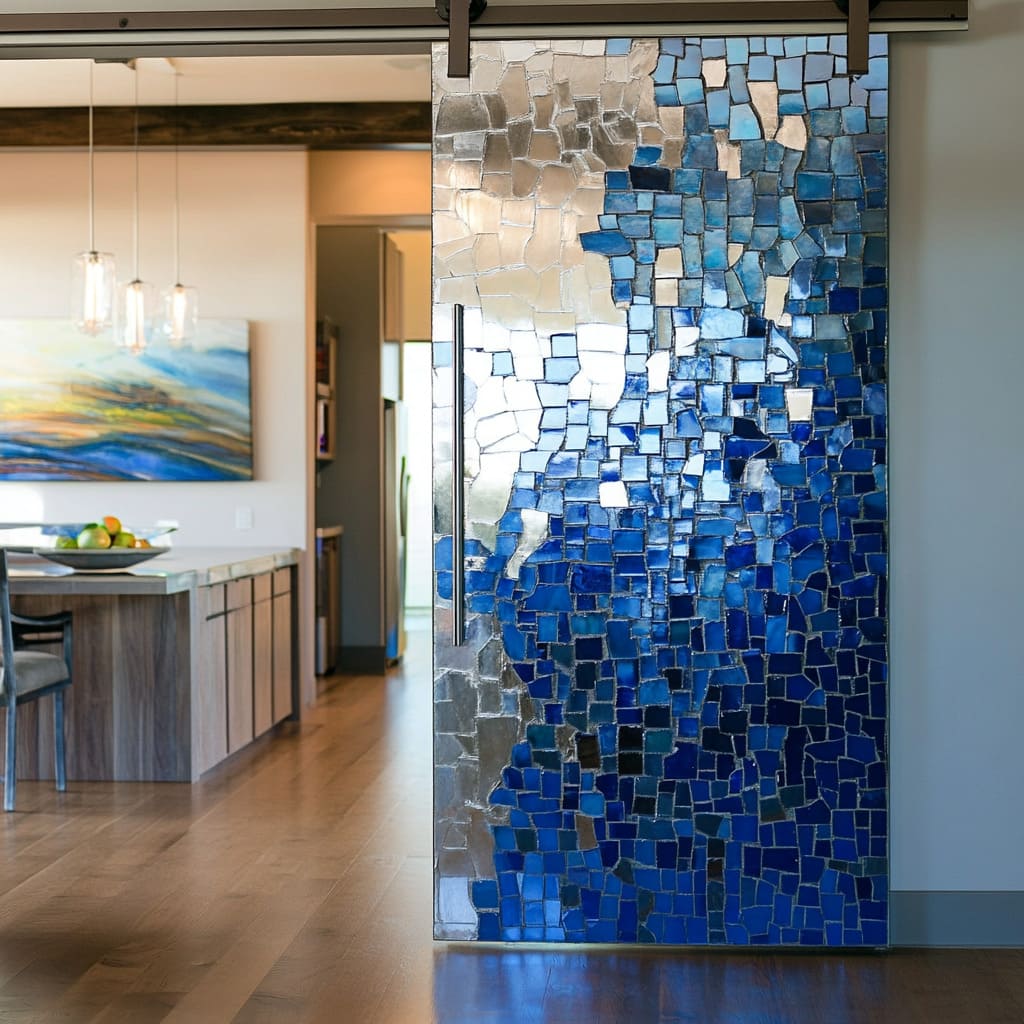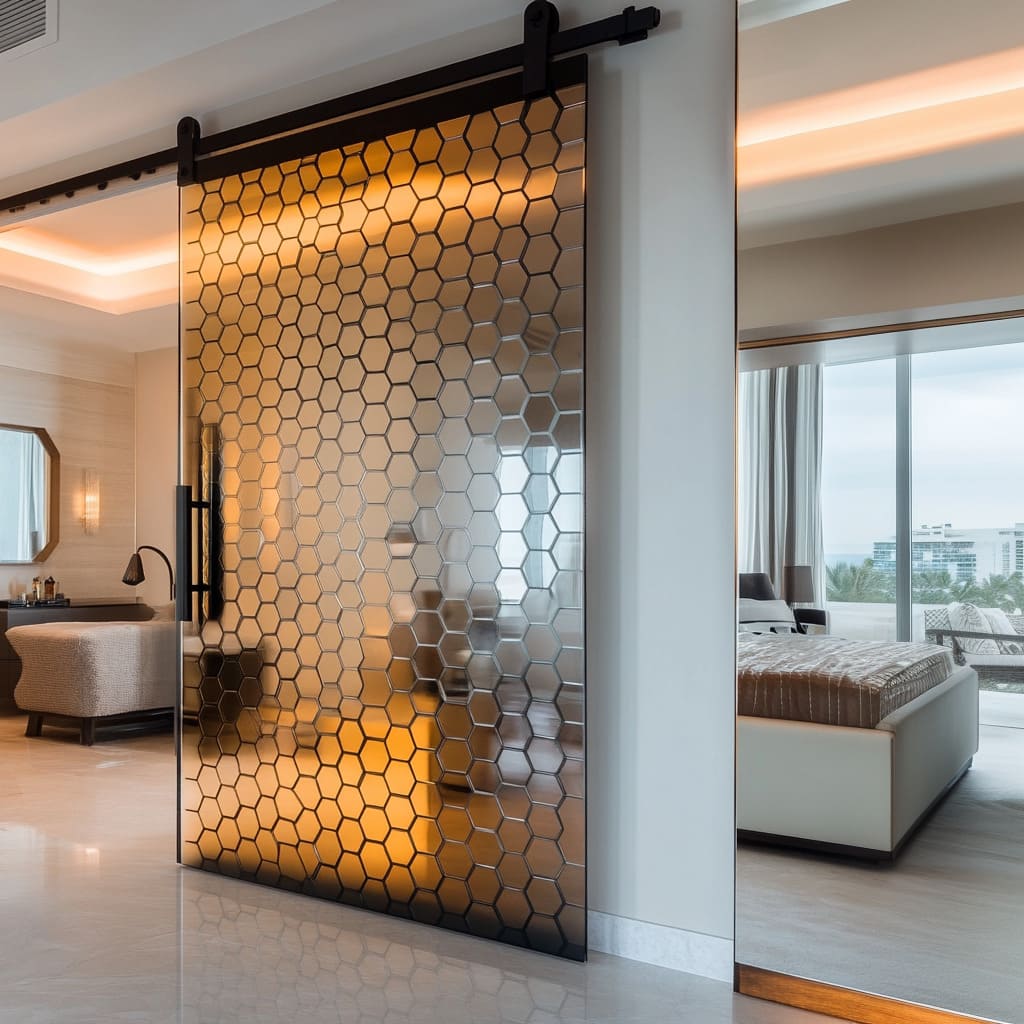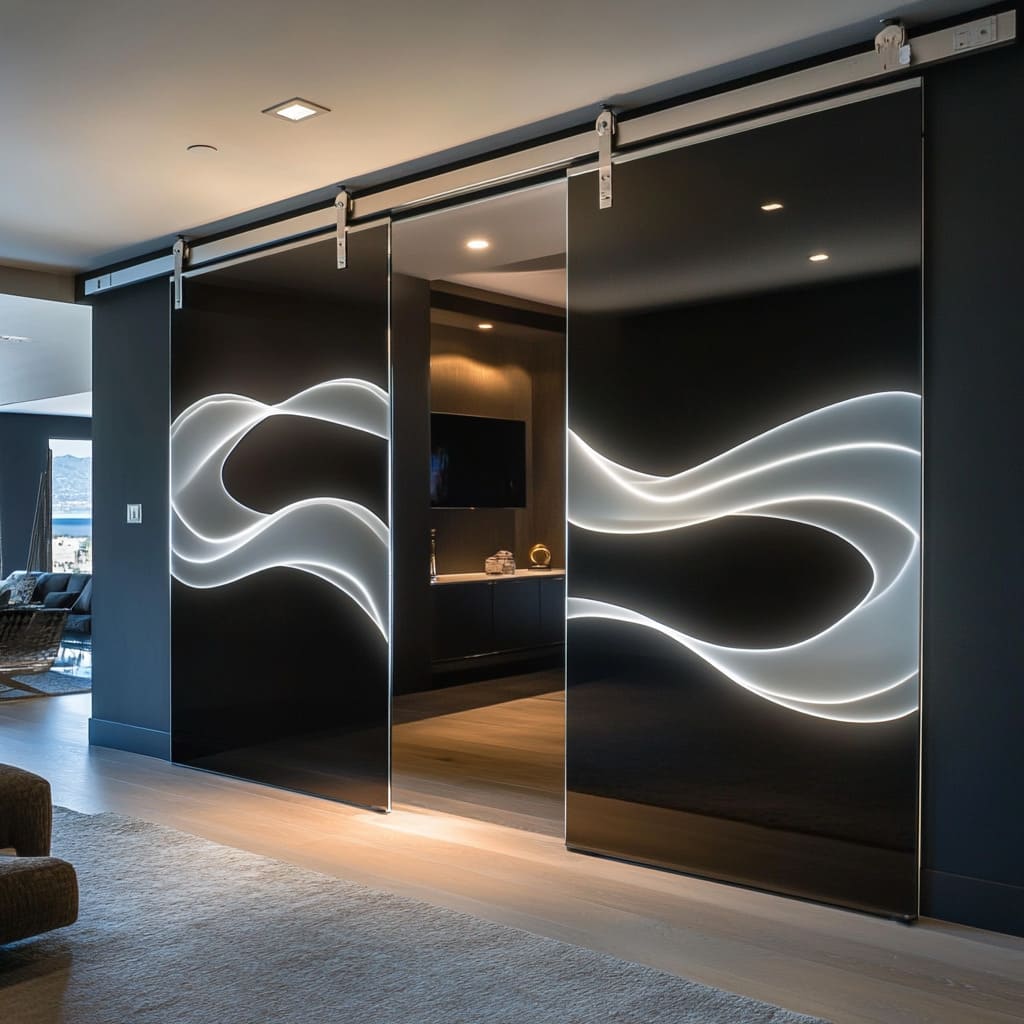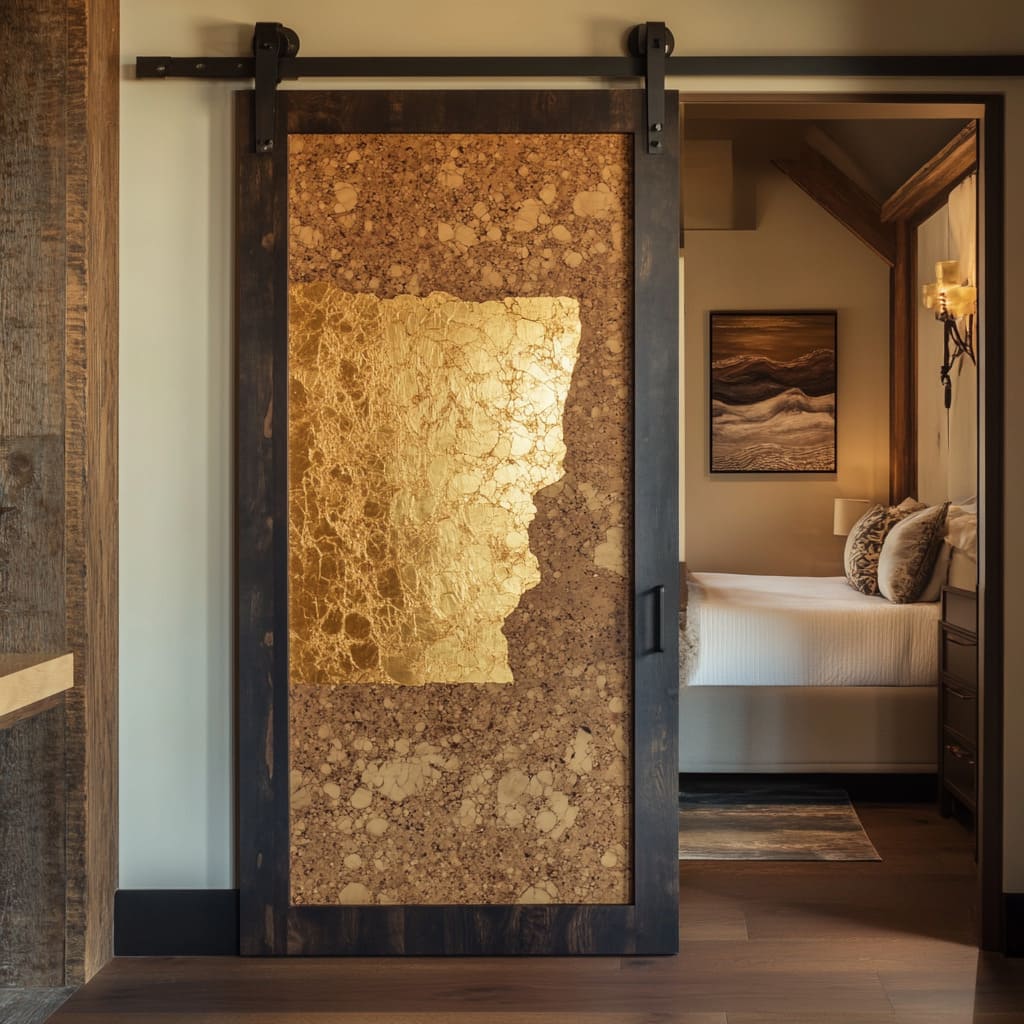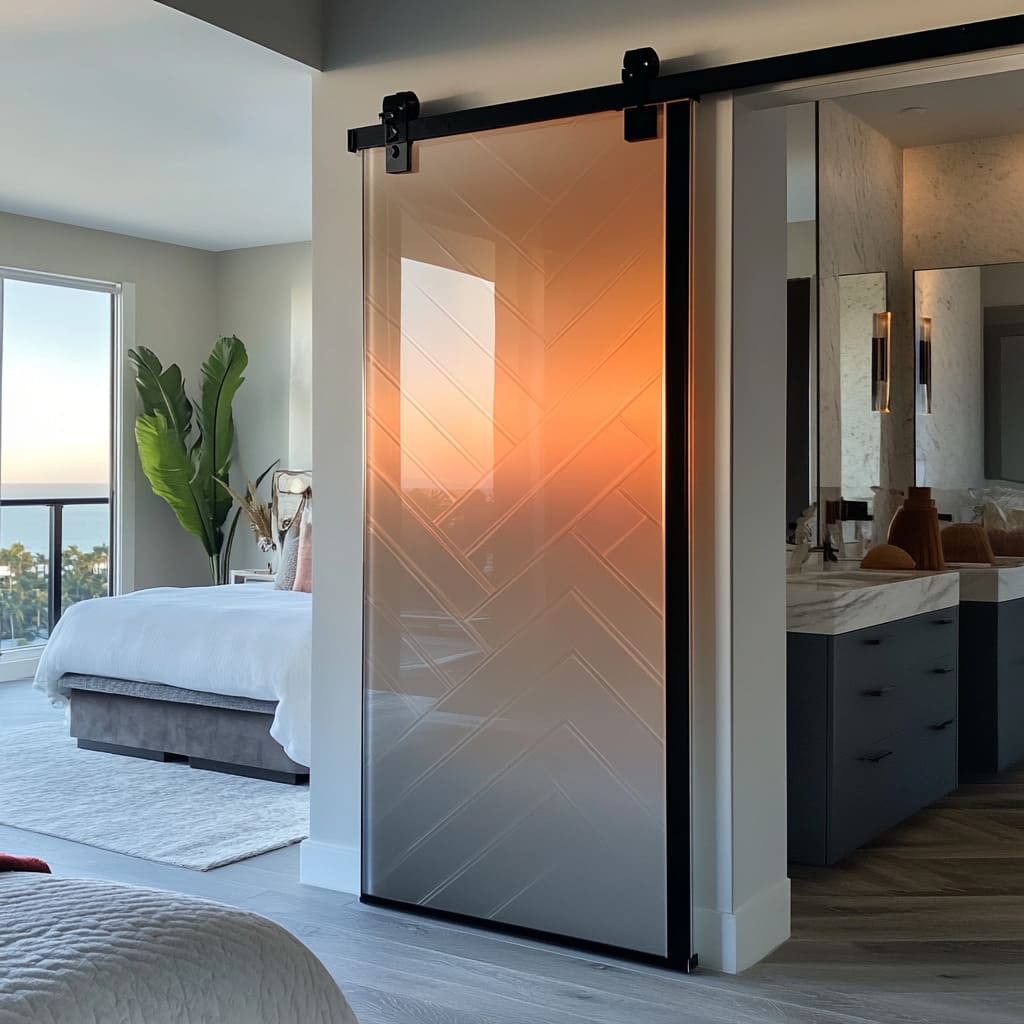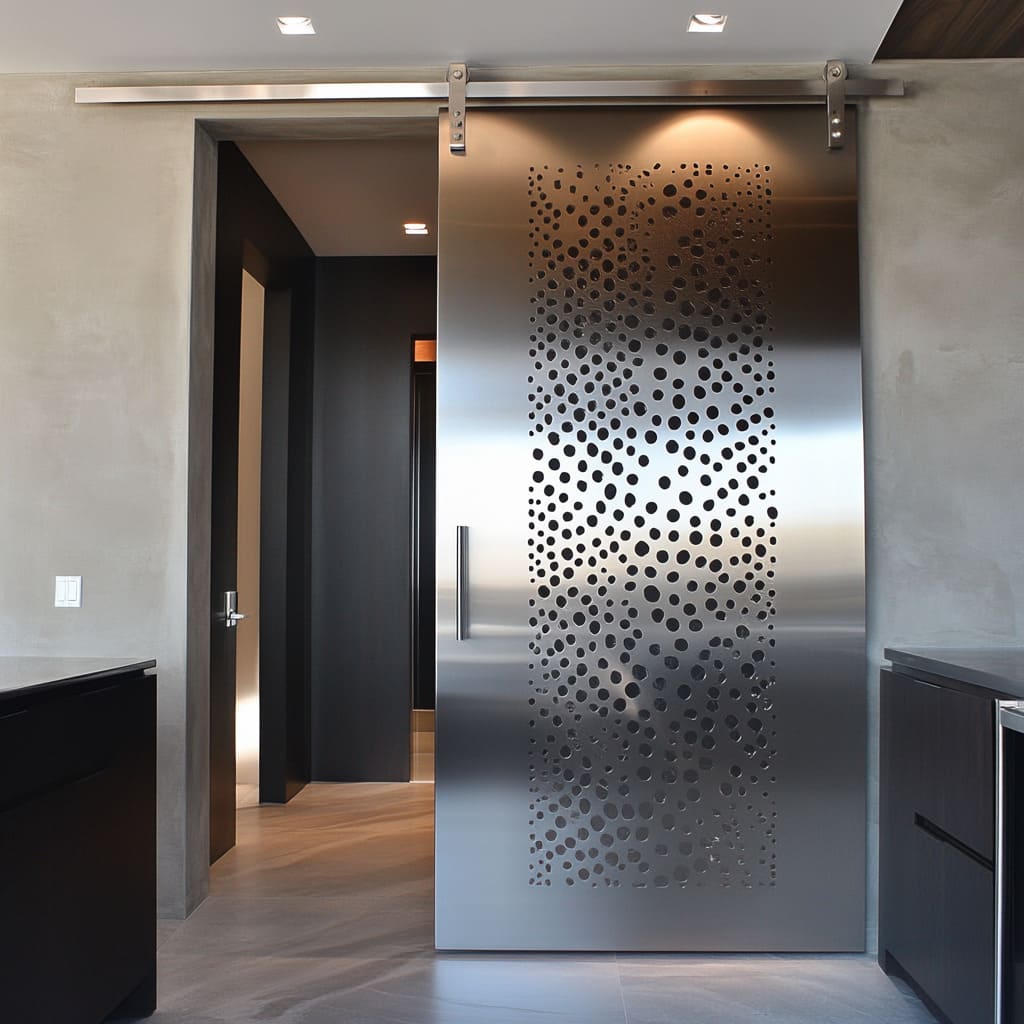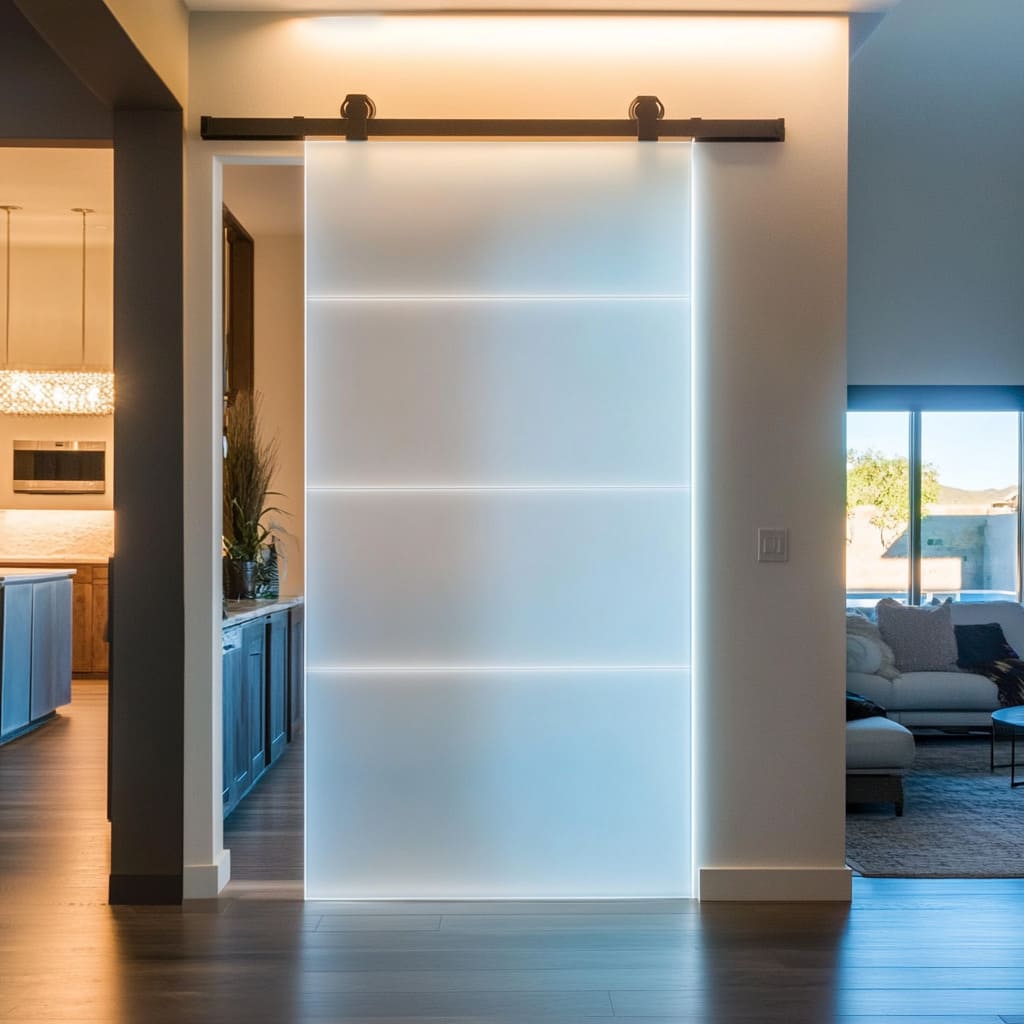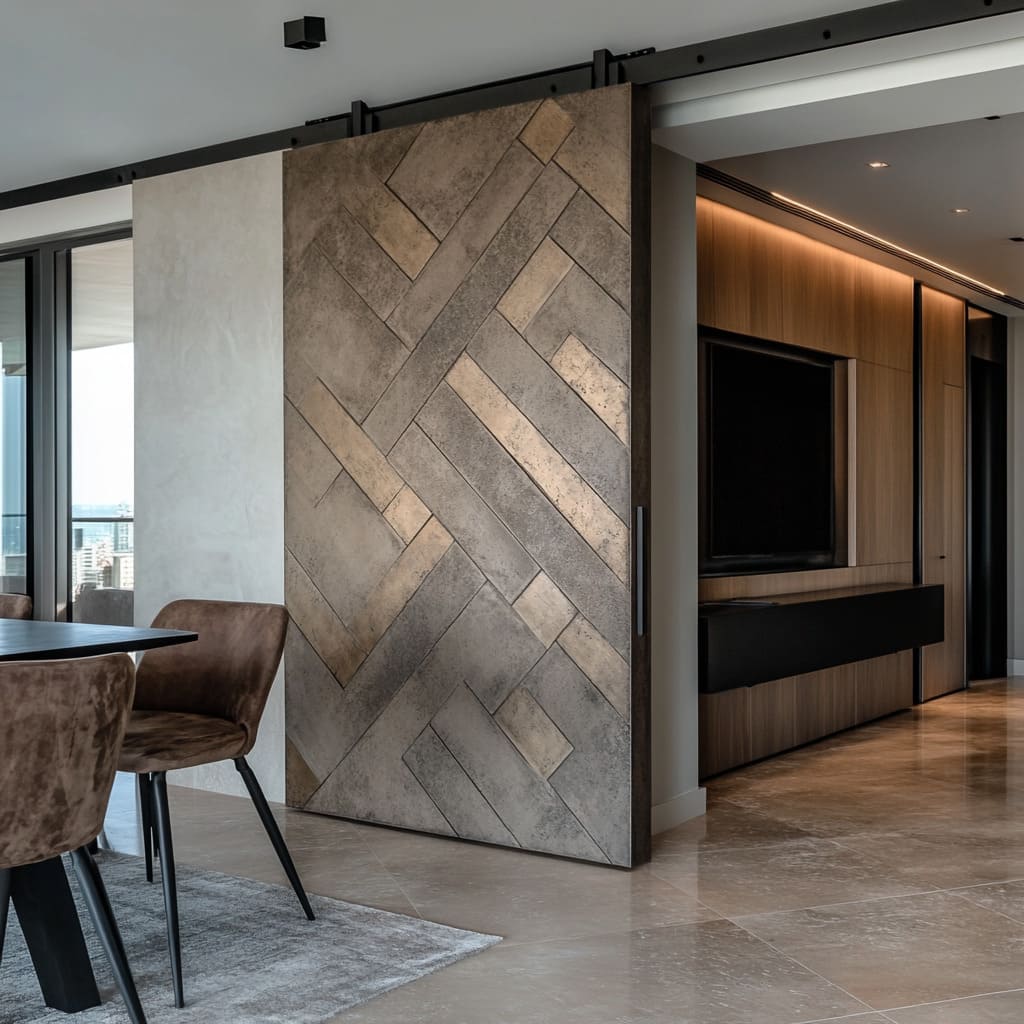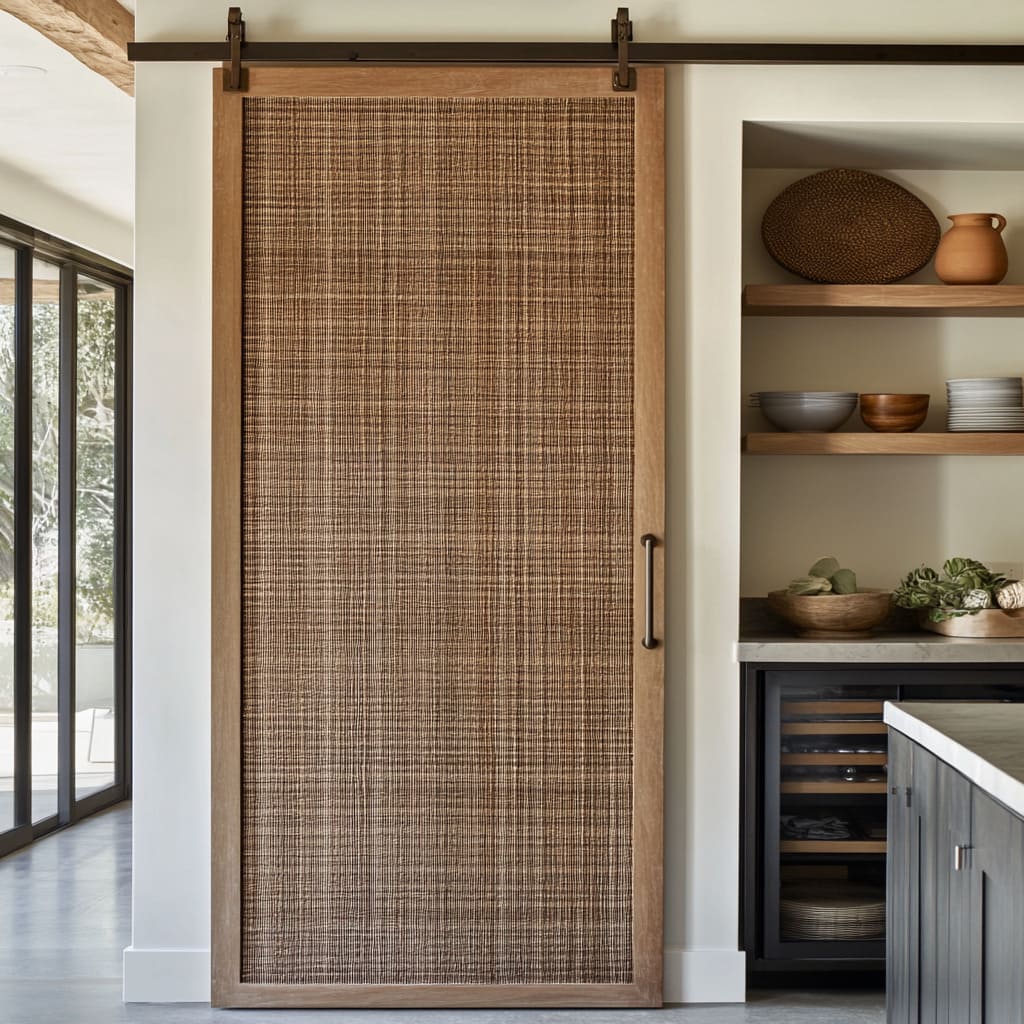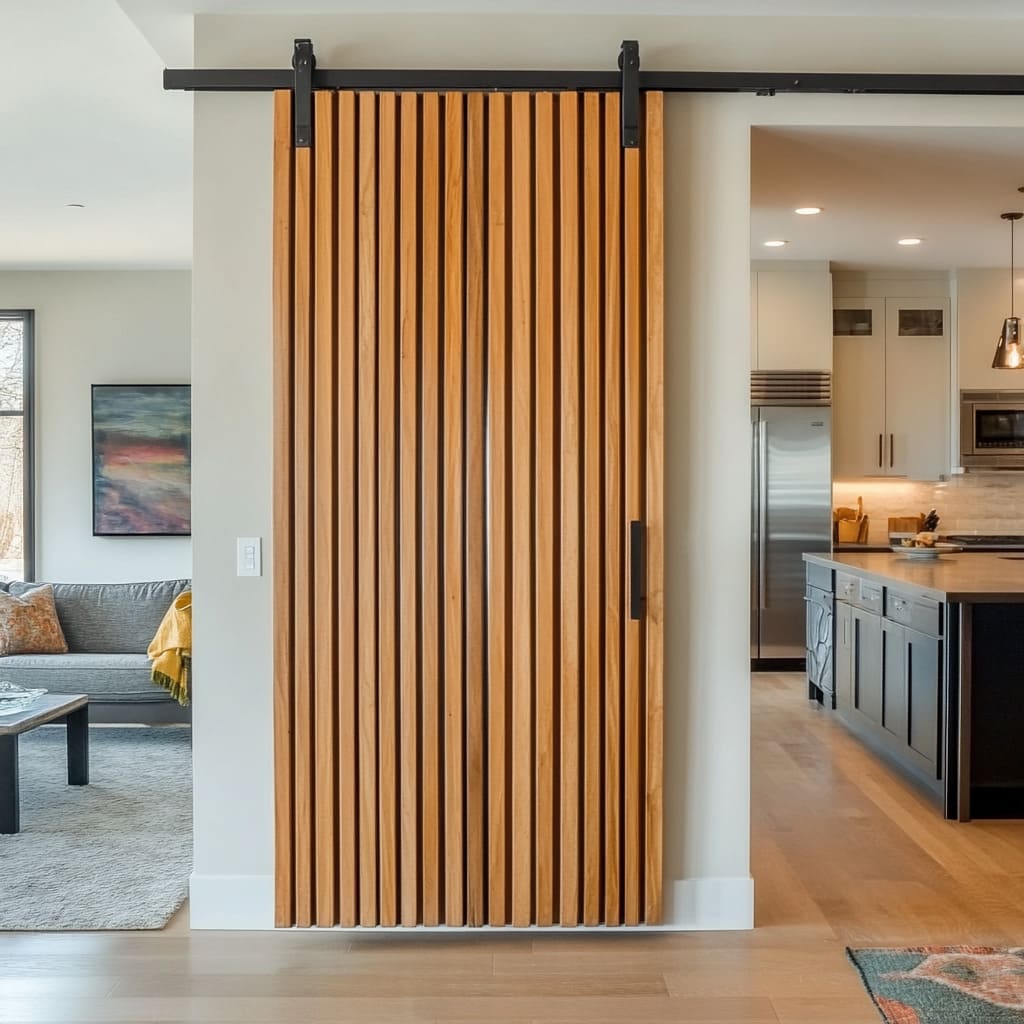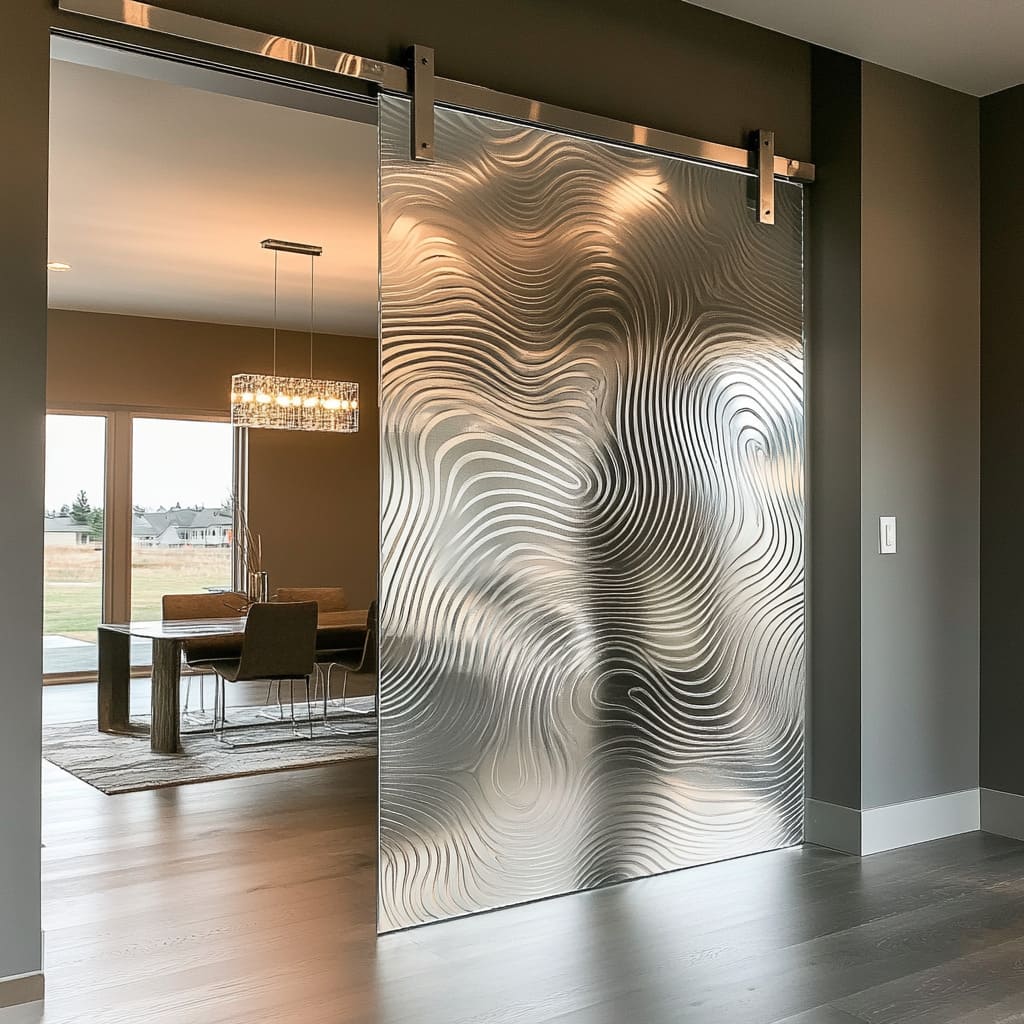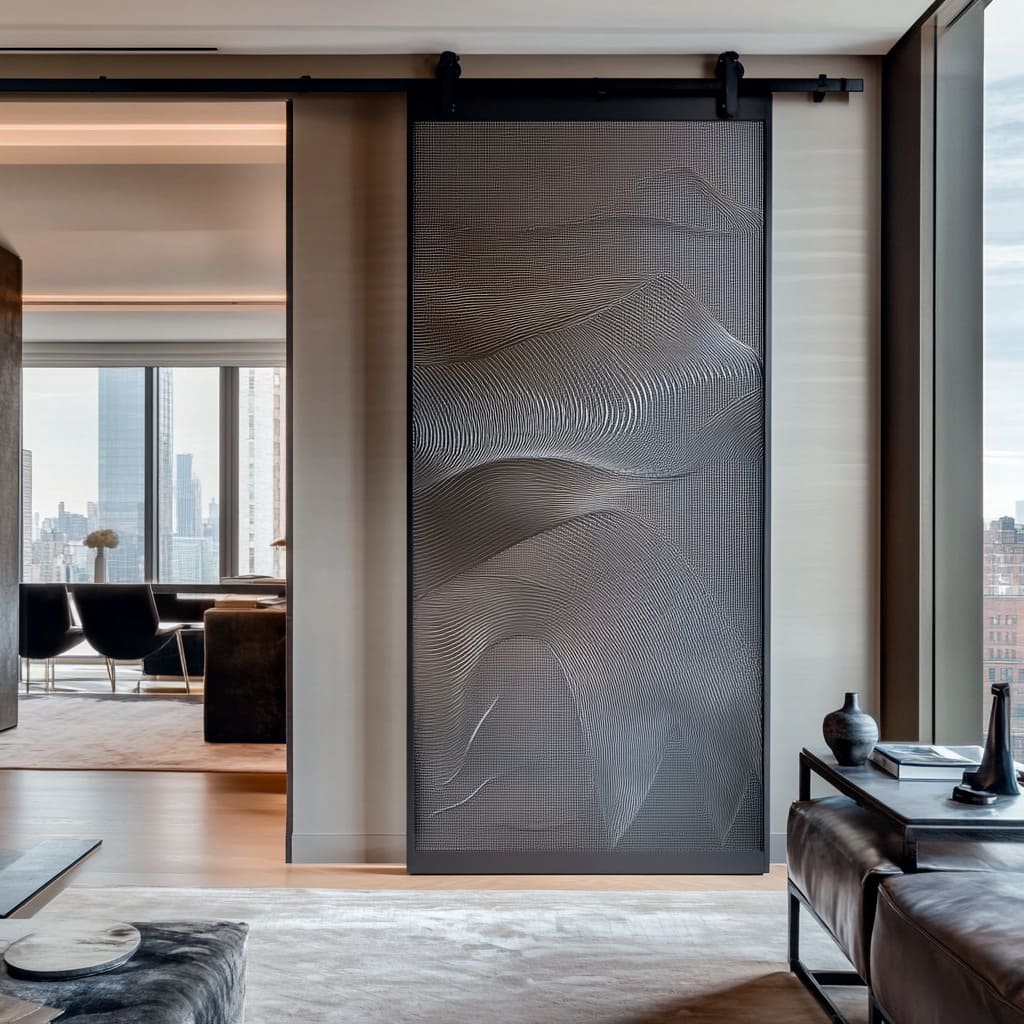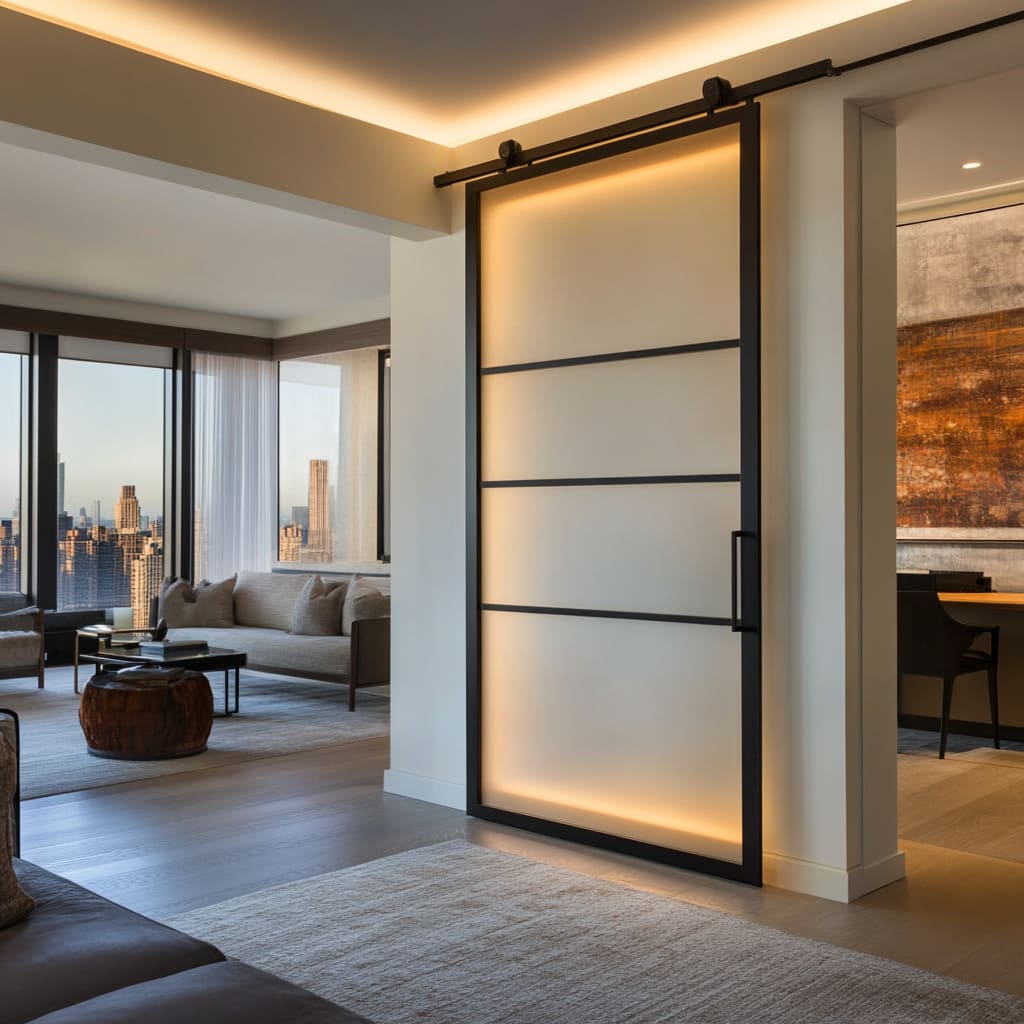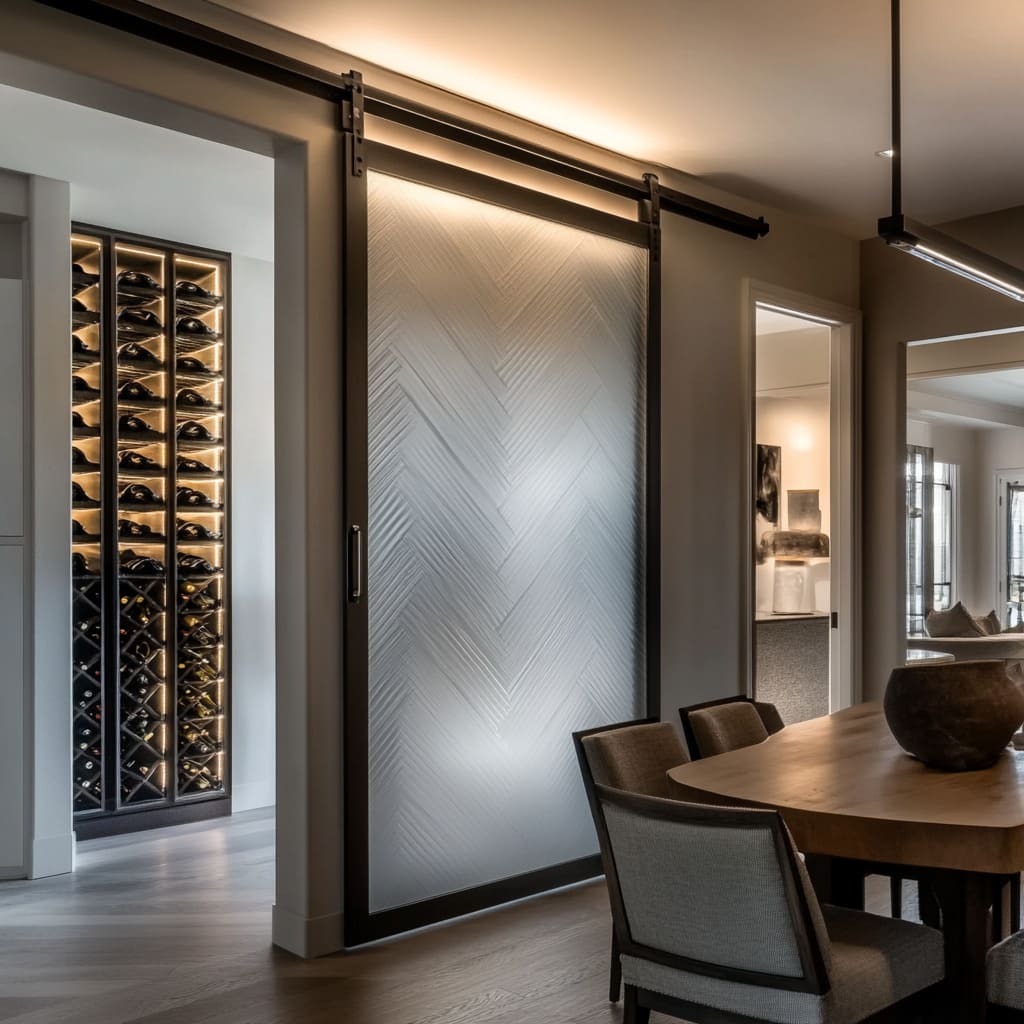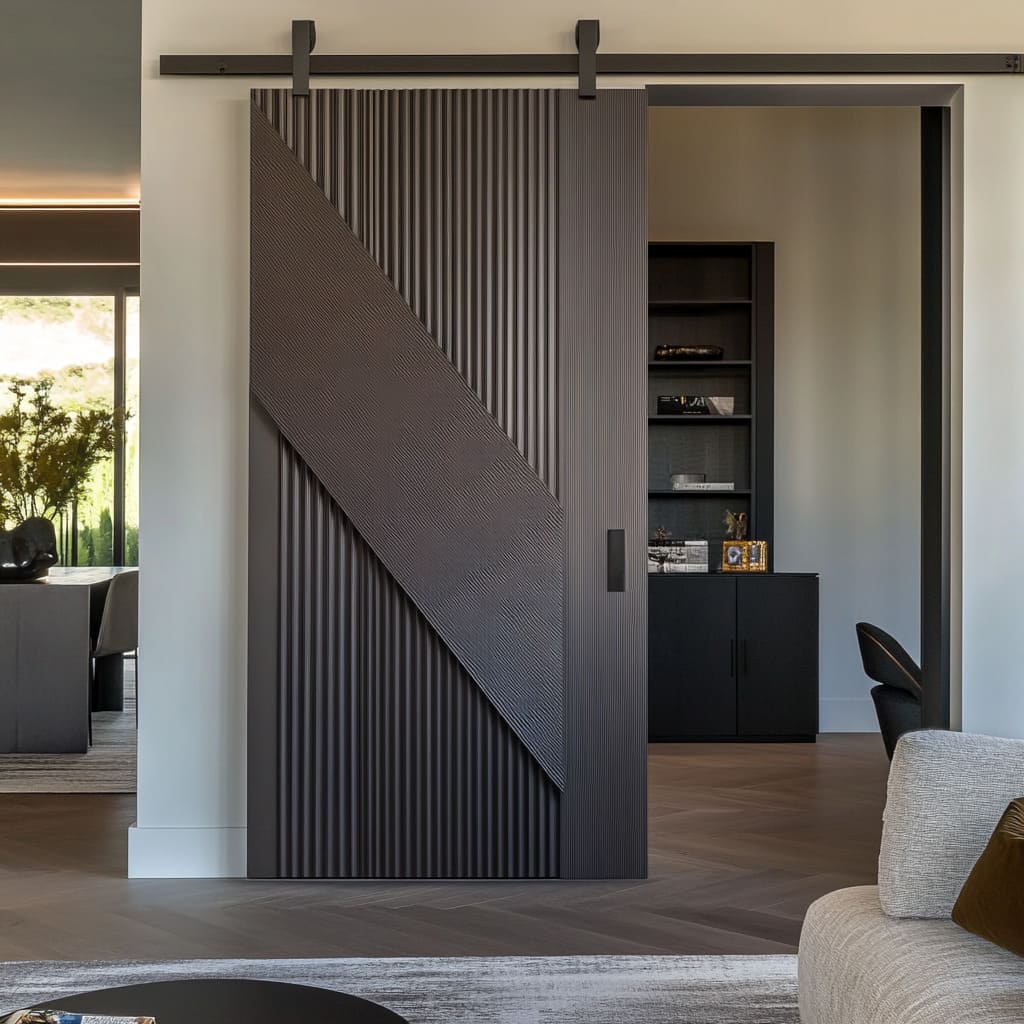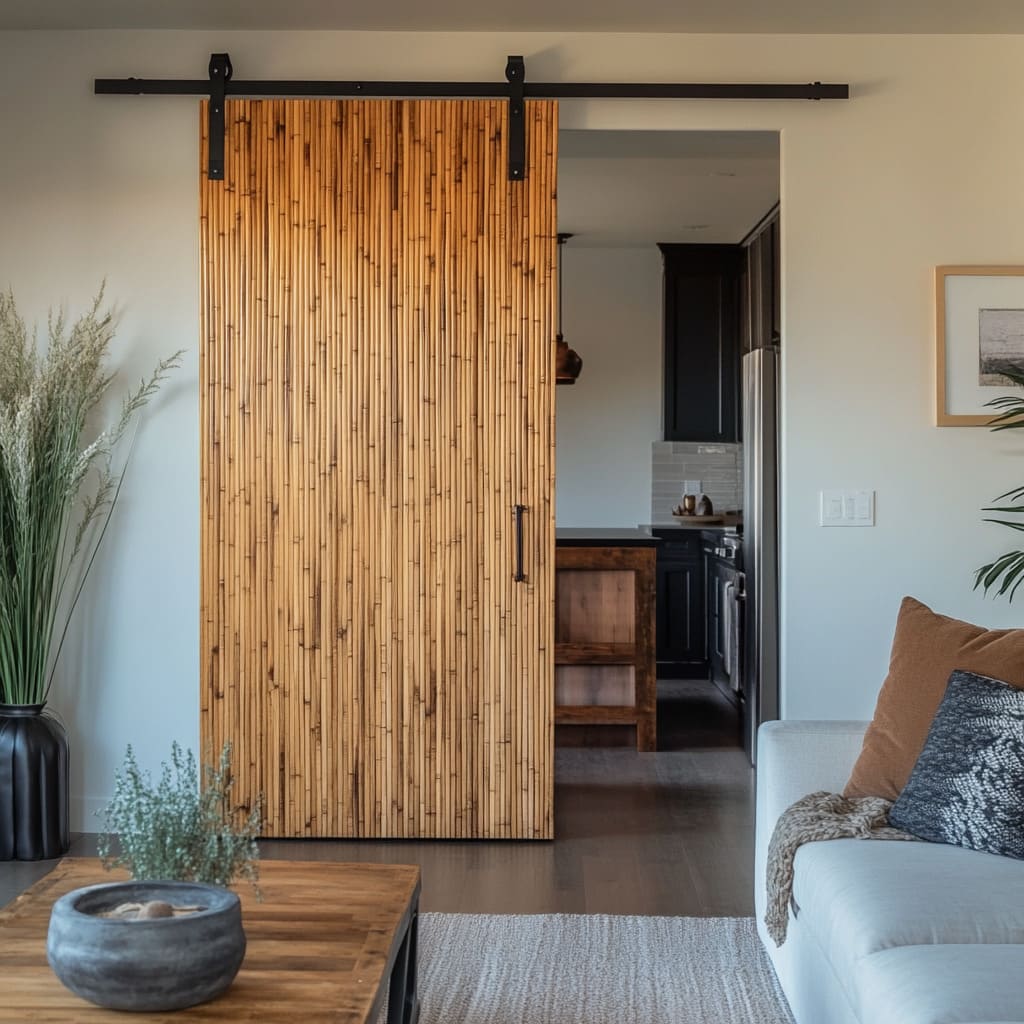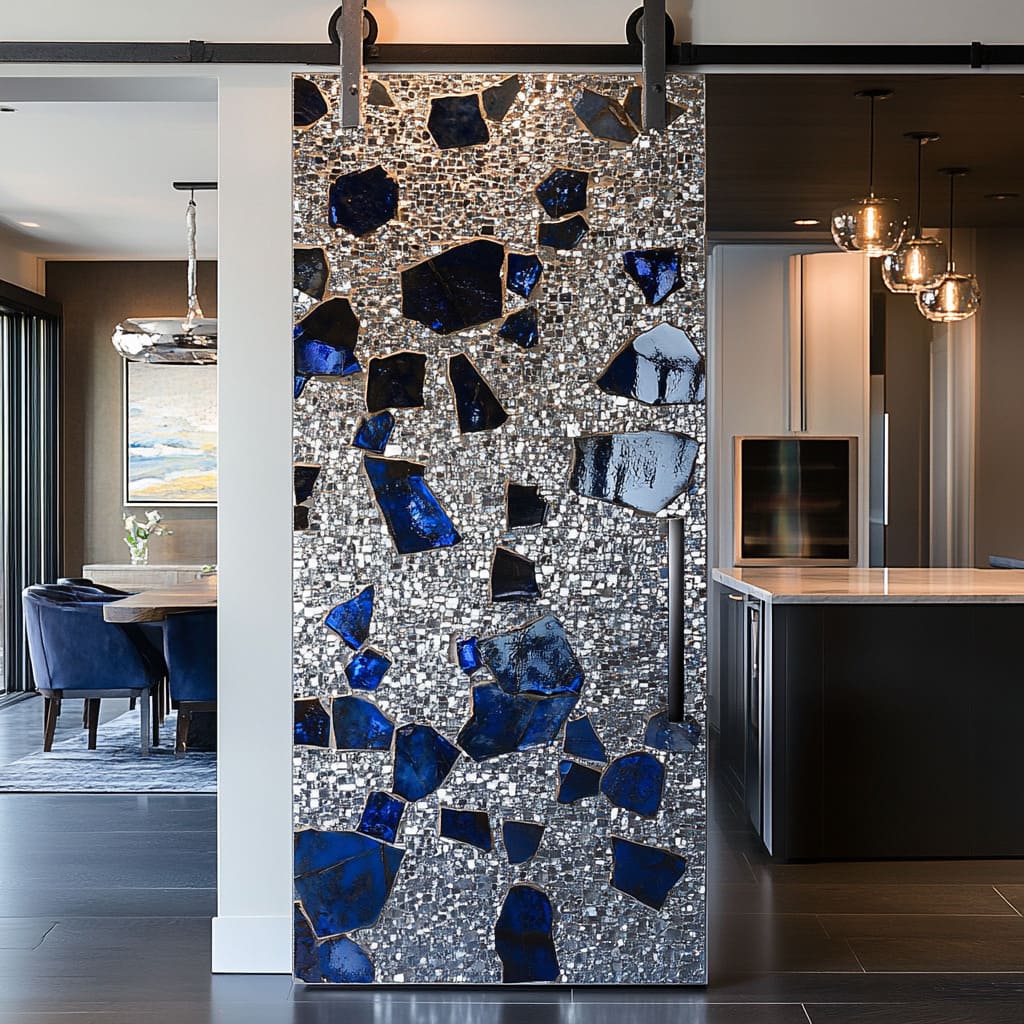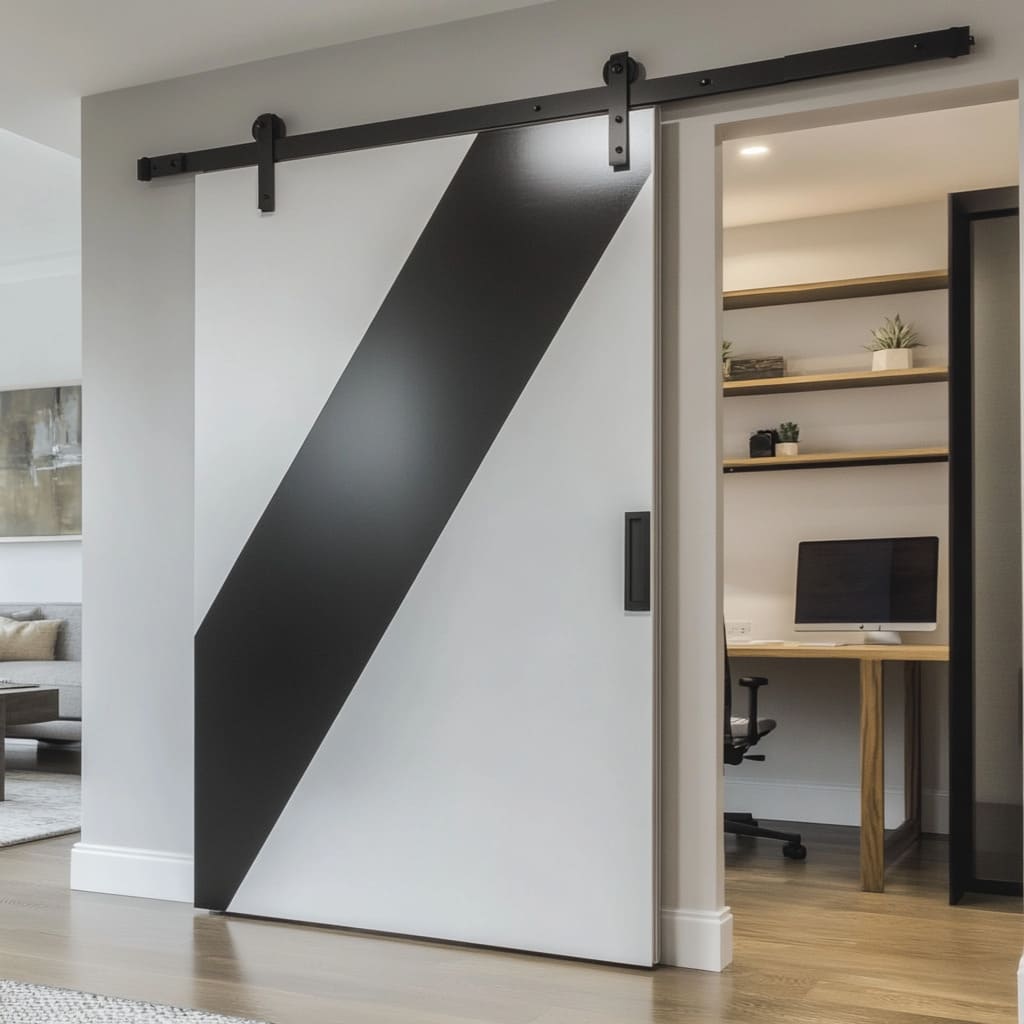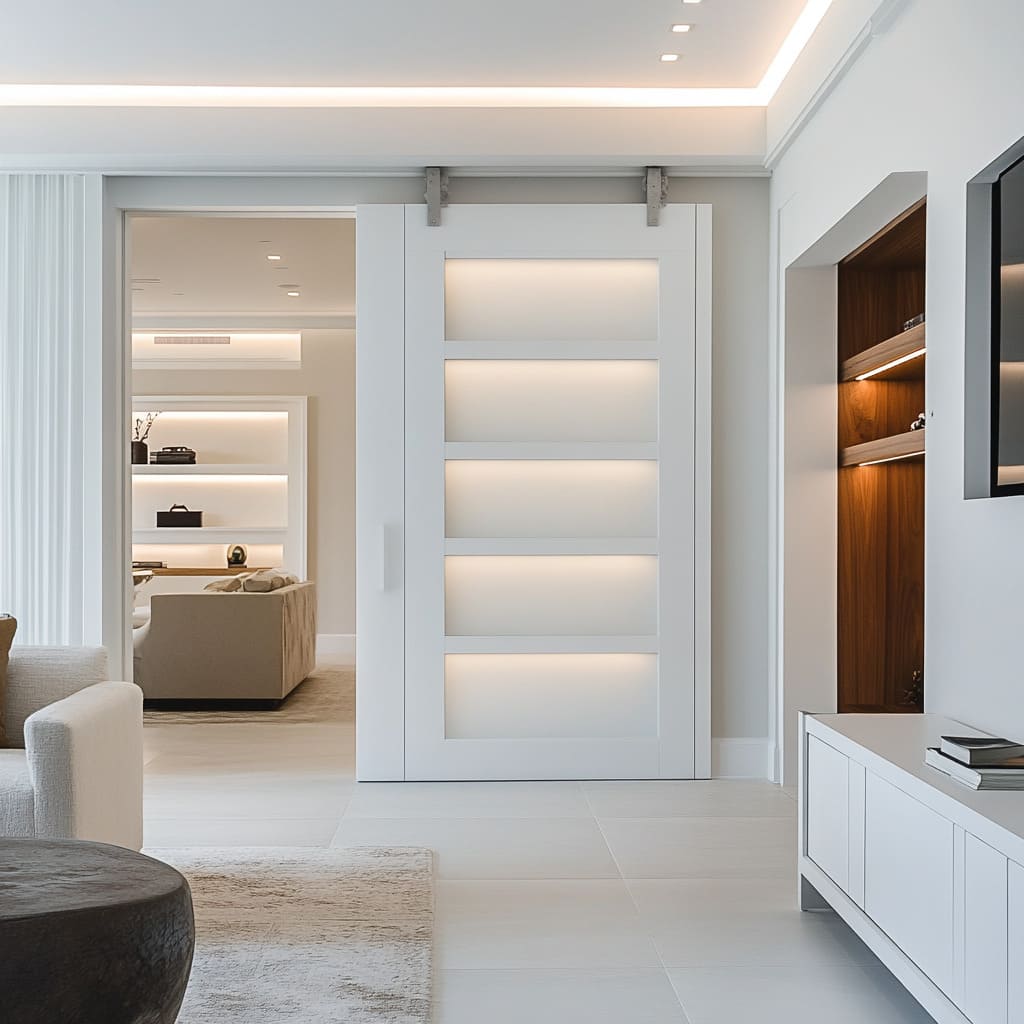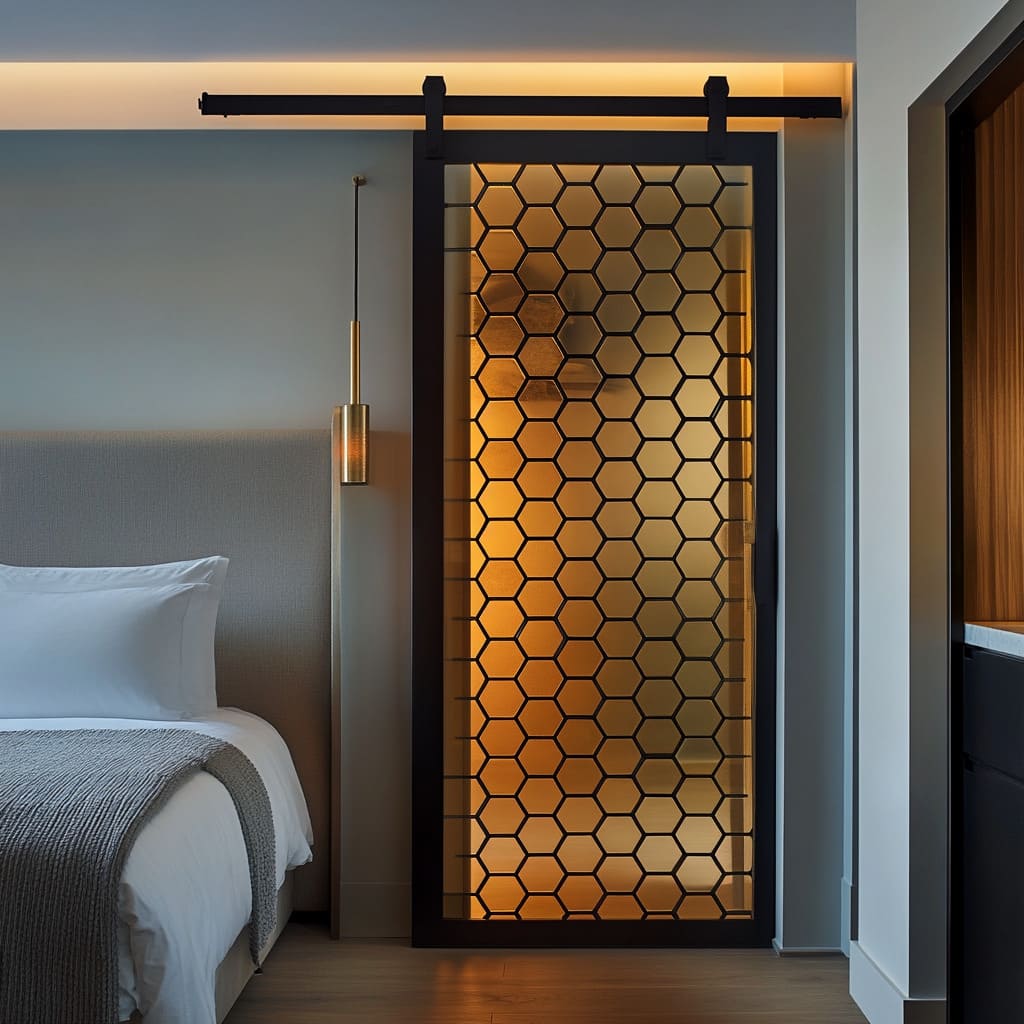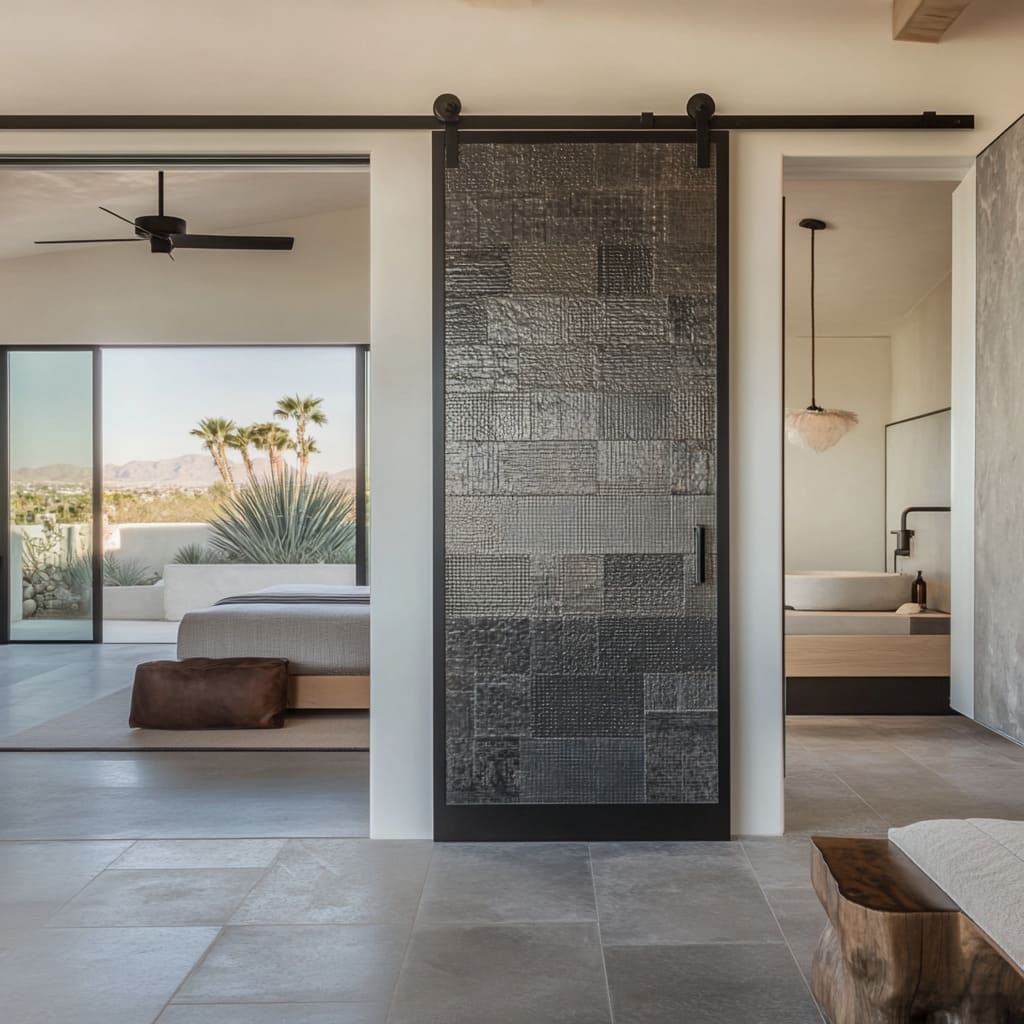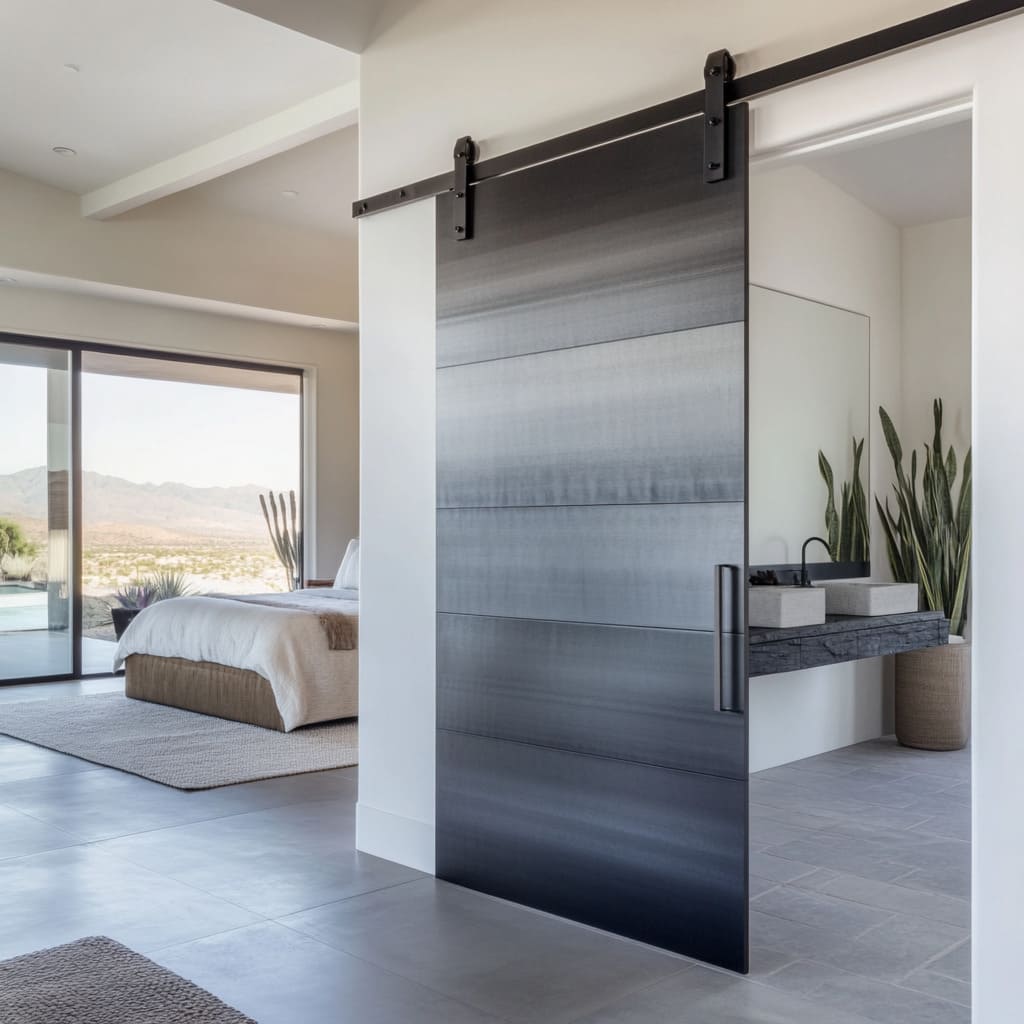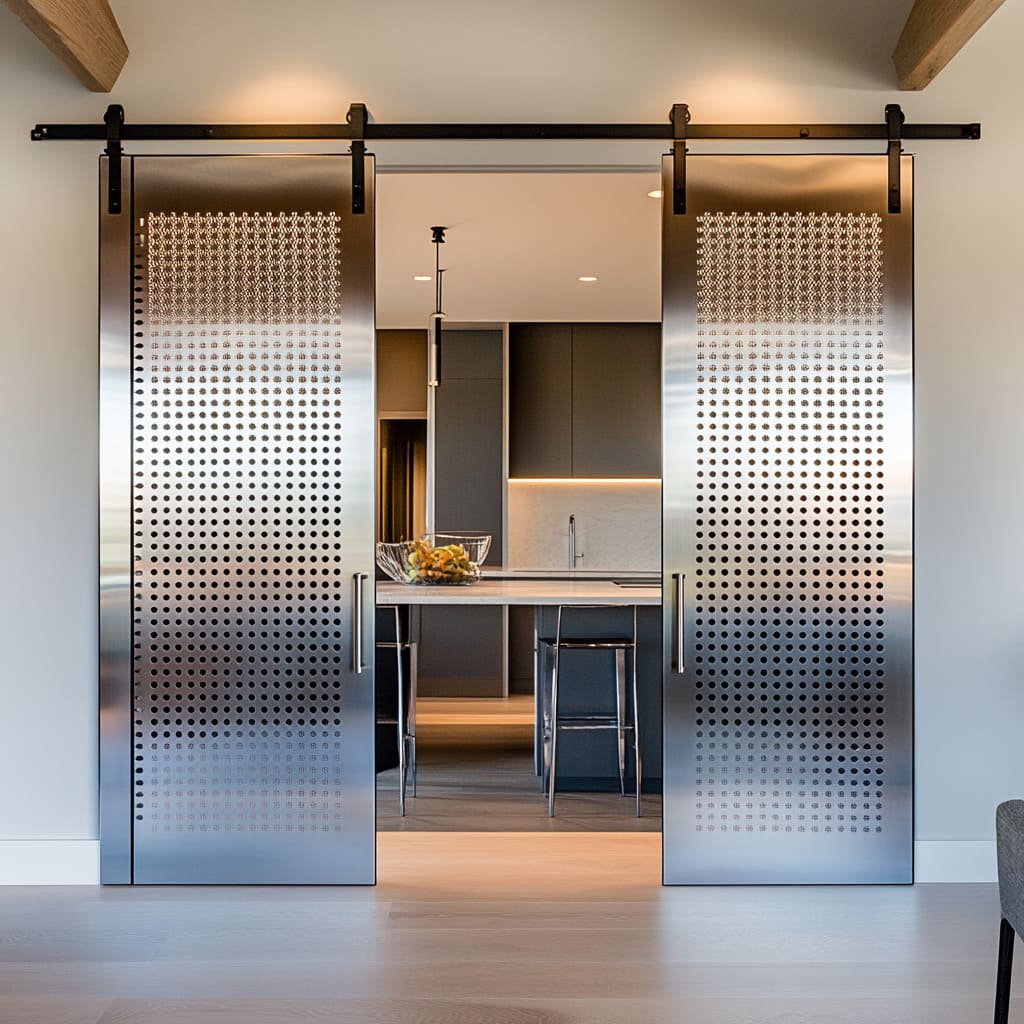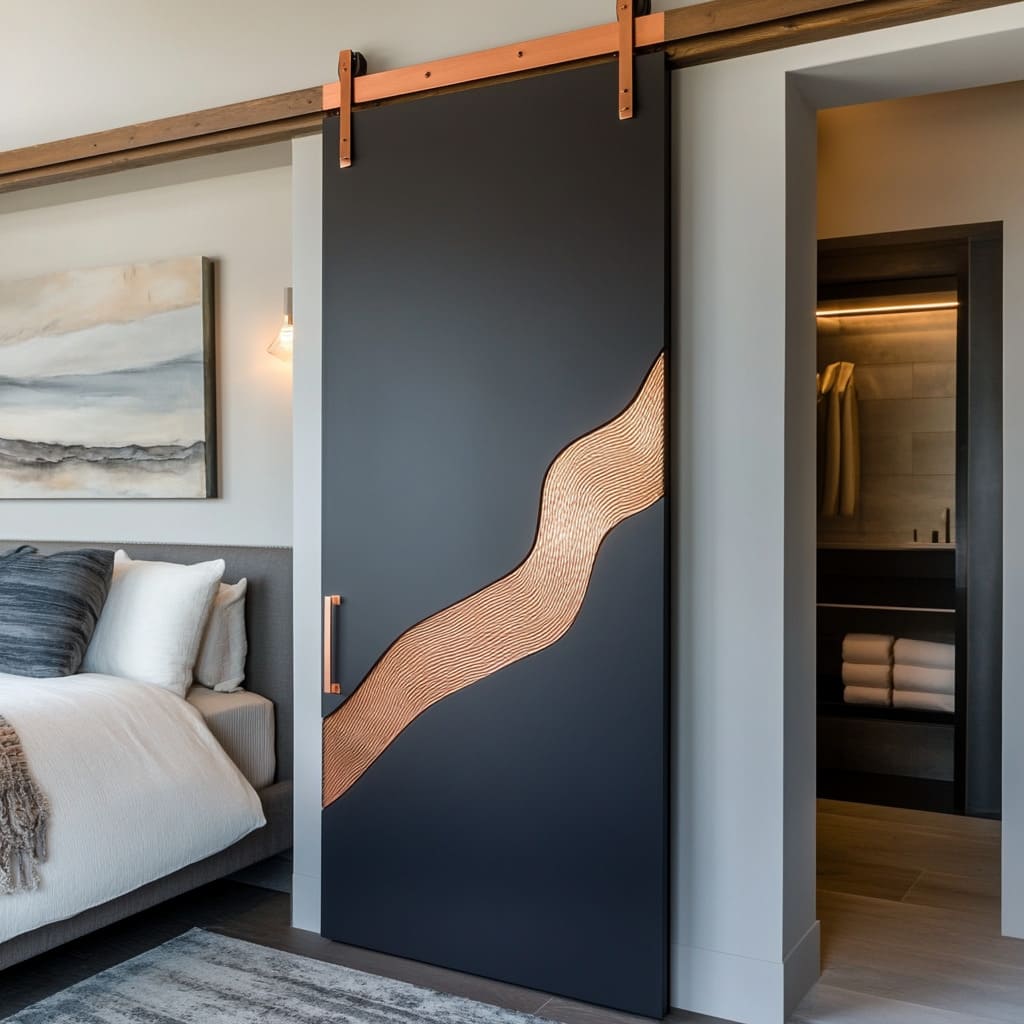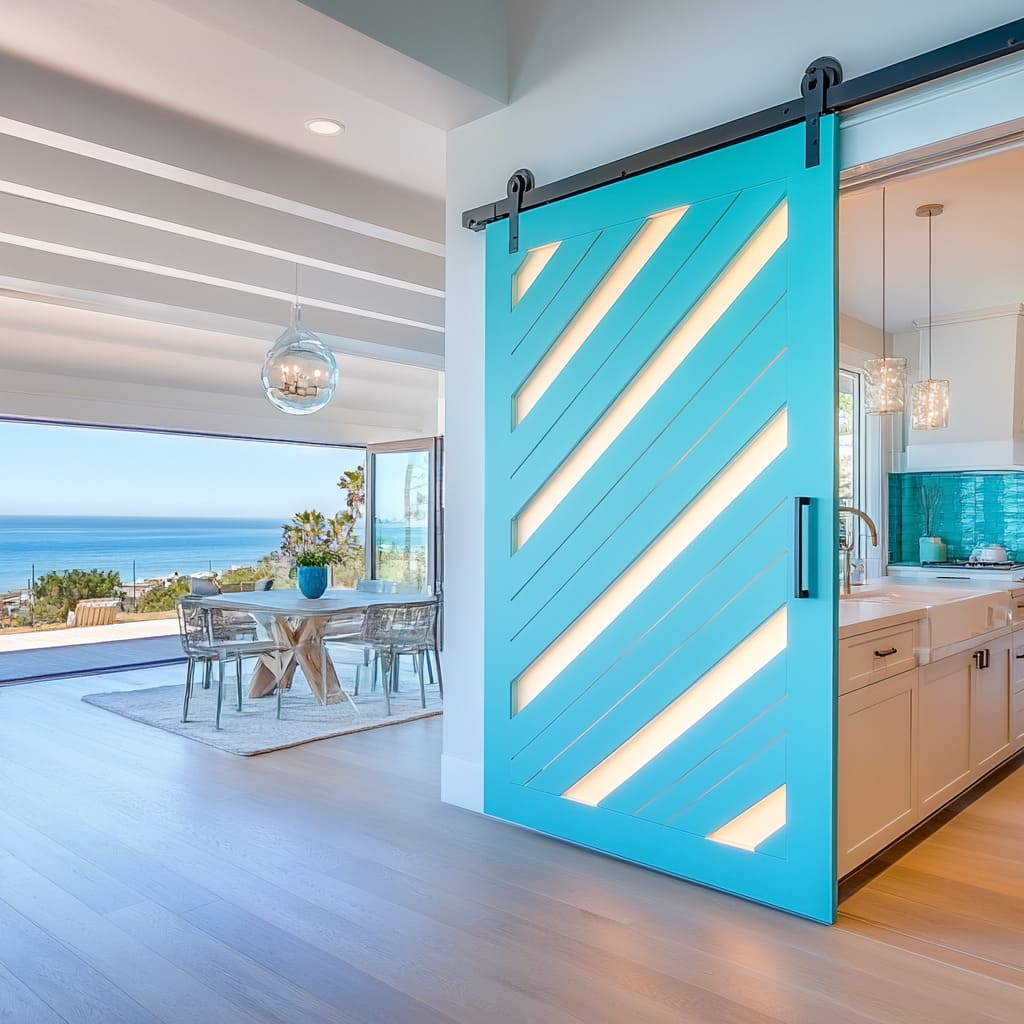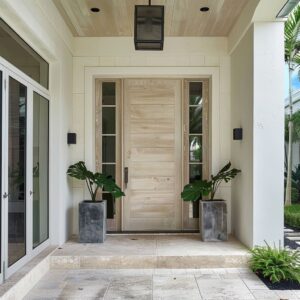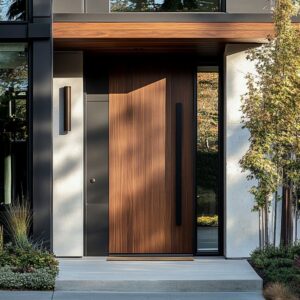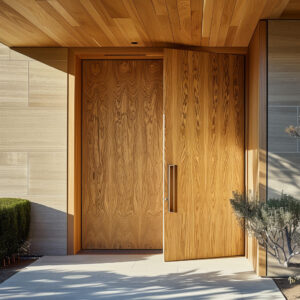Modern barn doors have come a long way from their origins, evolving into versatile design elements that suit a wide range of interiors. No longer confined to rustic settings, these doors now span a variety of styles, including sleek contemporary designs, industrial-inspired aesthetics, and organic, nature-driven options.
With their ability to enhance functionality while making a strong visual statement, barn doors have become a favorite for homeowners and designers alike.
What makes modern barn doors so appealing is their dual role as practical solutions and standout features. They can efficiently divide spaces in open layouts, add privacy without sacrificing light, and even contribute to noise reduction—all while introducing character to a room.
From minimalist frosted glass doors that seamlessly blend into a neutral palette to richly textured wood panels that add warmth and personality, these designs are as diverse as the spaces they inhabit.
The beauty of barn doors lies in their adaptability. They can complement a wide array of styles, from the clean lines of a modern kitchen to the cozy warmth of a rustic living room.
Whether you’re inspired by polished metal finishes for an industrial vibe, intricate mosaics for an artistic touch, or eco-conscious materials like bamboo or cork, there’s a barn door design to suit every preference. This guide will take a closer look at the design potential of barn doors, exploring their materials, textures, lighting options, and how they interact with the spaces they occupy.
By the end, you’ll see how these doors are more than just functional—they’re an opportunity to bring style and individuality into your home.
Material Insights and Why They Matter
Concrete and Terrazzo
Concrete, once synonymous with industrial functionality, has evolved into a design material that balances strength and sophistication. When polished or given intricate patterns, it introduces a tactile surface that pairs beautifully with contrasting materials like soft rugs or warm wooden floors.
This balance creates an interplay of textures that can elevate even the simplest spaces.
Terrazzo, with its embedded stone chips, brings an entirely different character. The speckled effect allows for subtle color shifts depending on the light source, making it a standout choice for doors near windows or brightly lit areas.
This versatility ensures that the material remains dynamic, adapting to its environment throughout the day.
Metal and Metallic Finishes
Metal finishes are a go-to for infusing spaces with personality. Brushed steel and perforated stainless offer sleek, modern vibes, perfect for industrial-inspired interiors.
Meanwhile, matte black frames add understated drama, grounding the space without overwhelming it.
For those who enjoy a touch of boldness, accents like copper patina or gold inlays bring a layer of sophistication. These reflective elements brighten darker finishes, catching and scattering light in subtle ways.
Whether used sparingly or as a focal point, metals introduce depth and contrast, especially when paired with neutral surroundings.
Sustainable and Organic Elements
The appeal of natural materials like bamboo, rattan, and cork lies in their warmth and authenticity. These materials resonate with a desire for eco-conscious choices, offering textures that feel alive and inviting.
Bamboo’s fine grain patterns and cork’s soft texture lend themselves to spaces seeking a connection to the outdoors. Reclaimed wood doors, often arranged in artistic patterns, carry a sense of history within their grains and knots.
Each piece contributes a unique element to the design, showcasing craftsmanship while embracing imperfections that tell a deeper story. These modern barn door designs often blend organic textures with contemporary forms, bridging traditional warmth and modern aesthetics.
Glass Variations
Glass options provide unmatched versatility in modern interiors. Fully transparent doors allow for visual continuity, perfect for maintaining openness while still defining spaces.
Lightly frosted glass takes this a step further by introducing a sense of privacy without sacrificing brightness.
For a more artistic approach, deeper etchings or wave-like patterns on frosted glass create a decorative barrier. These designs let light filter through while offering privacy, making them ideal for areas where separation is needed without the heaviness of a solid door.
Whether used for their artistic or functional properties, glass variations bring a sleek and modern edge to interior spaces. By thoughtfully combining these materials, designers create doors that function as more than just partitions.
They act as statements, blending practicality with aesthetic appeal, and becoming an integral part of a space’s character. Modern barn door designs showcase how these materials work together to enhance homes in stylish and innovative ways.
Beyond the Obvious: Patterns, Texture, and the Power of Visual Rhythm
Hidden Geometry and Pattern Choice
Patterns like herringbone, chevron, and honeycomb bring more to a design than meets the eye. These choices actively shape how we perceive a space, creating a sense of movement and focus.
For example, diagonal motifs act as subtle visual cues, guiding attention upward or emphasizing the room’s width. When echoed in textiles, furniture, or wall art, these patterns establish harmony throughout the space, transforming a single element, like a door, into a unifying feature.
This is particularly effective when considering modern barn door ideas that aim to blend form and function seamlessly.
Textured and Perforated Surfaces
Textures and perforations are often overlooked as functional tools, yet their impact is undeniable. Perforated metal panels or deeply etched designs, like wave or bubble textures, manipulate light in fascinating ways, scattering it to create shifting shadows and silhouettes.
This play of light adds a dynamic quality to interiors, allowing them to subtly change throughout the day.
In other designs, materials like textured glass, ceramic tiles, or wood mosaics are used to craft intricate surfaces that engage both sight and touch. These details elevate the simple idea of a barn door into a design centerpiece that balances practicality with artistry.
Layering Transparency and Reflection
Combining materials that offer transparency and reflection enhances both function and ambiance. Frosted glass, paired with integrated LED lighting, creates a soft, glowing partition that provides privacy without sacrificing light.
This technique is particularly effective in open-concept layouts, where maintaining light flow is essential. Meanwhile, reflective elements, such as mirror finishes or smoky metallic gradients, contribute a sense of depth.
These materials bounce light across a room, making compact spaces feel more open and airy. Gradients on metal surfaces, for instance, suggest vertical movement, subtly drawing the eye upward to make ceilings appear higher.
When integrated thoughtfully, these design strategies turn a practical feature like a sliding barn door into a vital part of the overall aesthetic. They demonstrate how rhythm, texture, and the balance of light can shape interiors in unexpected yet impactful ways.
Lighting, Color, and Their Impact on Mood
LED Integration
Modern designs have embraced the subtle power of LED strips, blending functionality with aesthetic appeal. When placed behind frosted panels or within intricate patterns like diagonal or wave-like cuts, these strips serve as more than just decorative elements.
They become functional lighting tools, gently guiding pathways in dim conditions or accentuating the textures of the door’s surface. The interplay between shadow and light adds depth to what might otherwise be a flat partition.
Illuminated glass edges create a soft, ambient glow, which is especially effective in open floor plans. These glowing outlines help define distinct areas, such as separating a kitchen from a dining space or highlighting transitional zones like hallways.
This nuanced lighting approach enhances spatial awareness without the need for heavy physical barriers.
Contrast and Composition
The use of contrast, such as dark frames paired with lighter panels or bold monochromatic patterns, brings visual weight and structure to the design. These choices turn a door into more than a divider—it becomes a focal point that guides the overall flow of a space.
Reflective materials, including metallic and mirrored surfaces, go one step further by interacting with the room’s surroundings. They reflect colors, textures, and lighting from nearby elements, making the door feel integrated into the broader design while adding subtle layers of interest.
When paired with pendant lights, these surfaces take on dynamic qualities, shifting their appearance based on the viewer’s position.
Balancing Warmth and Coolness
Striking the right balance between warm and cool tones can transform a room’s atmosphere. Materials like natural wood, golden accents, and soft amber lighting introduce warmth, which offsets the sterility that can sometimes accompany concrete, metal, or black glass.
This intentional blend of materials ensures that spaces feel inviting while maintaining a sleek and modern aesthetic.
For a more dynamic effect, frosted glass paired with tinted LED backlighting offers customizable options. By shifting between warmer oranges and cooler blues, the door’s mood can adapt to the time of day or the desired ambiance of the space.
This level of versatility makes modern barn doors with glass a perfect choice for those looking to merge style with practicality.
Incorporating these lighting and color strategies ensures that doors are no longer overlooked as mere functional pieces. They become key contributors to the overall design, setting the tone and enhancing the personality of any space.
Hardware Details and Why They’re Crucial
Track Systems
The track system is more than a functional element—it shapes the personality of the door. Exposed tracks, typically crafted in sleek black metal, give a nod to the classic barn door aesthetic while maintaining a contemporary edge.
Modern track designs with a slim, low-profile appearance ensure that they align with the clean lines of modern interiors, avoiding a purely rustic impression.
For doors made from heavier materials, such as thick glass or solid metal, the track’s mechanics must be exceptionally sturdy. This functionality is elevated into a design feature when visible bolts or hardware are intentionally emphasized, adding a sense of craftsmanship and industrial charm.
Handle Placement and Style
The handle style and placement are critical in defining the overall look of modern style barn doors. Recessed handles are a subtle choice, ensuring the door’s textured or patterned surface remains uninterrupted.
This approach works particularly well with doors that feature intricate designs or bold geometric elements, allowing the surface to take center stage.
On the other hand, bold handles or elongated pulls can double as statement pieces. These are often coordinated with other metallic elements in the room, such as faucets or light fixtures, to create a sense of continuity throughout the space.
In some designs, the finish or color of the handle is carefully matched with the track or an accent strip on the door, enhancing the sense of cohesion.
By blending practicality with style, the hardware transforms into more than a functional component—it becomes a refined detail that ties the door seamlessly into its surroundings. This attention to detail is what elevates modern style barn doors from simply utilitarian to striking design features.
Non-Trivial Observations that Elevate Style
Playing with Light Reflection Off Interior Furnishings
Doors with reflective surfaces—whether they feature mirrors, high-gloss finishes, or brushed metal—add an unexpected layer of depth to interiors. These surfaces interact dynamically with surrounding elements such as rugs, chairs, or wall art, subtly absorbing and reflecting their hues.
As natural light shifts throughout the day or artificial lighting is adjusted, these reflections transform, creating a dynamic interplay that keeps the space visually engaging. This effect becomes particularly striking in spaces with vibrant furnishings or bold accent pieces, as the door seems to “borrow” elements from its environment to enhance its visual presence.
Rhythmic Continuity with Flooring and Ceilings
Patterns such as herringbone, chevron, or mosaics on modern doors can echo similar motifs in the flooring or ceiling. For instance, a herringbone door paired with matching wood flooring creates a seamless visual thread that ties the room together.
Similarly, a mosaic-inspired panel can complement overhead beams or tilework, unifying vertical and horizontal design elements into a cohesive narrative. These repetitions aren’t just decorative—they lend a sense of intentionality to the entire interior, making it feel thoughtfully designed.
Visibility of Interiors as a Design Tool
Doors with semi-opaque glass or perforated sections invite a peek into adjacent spaces, turning what lies behind them into an integral part of the design. For example, a glimpse of a curated bookshelf, a carefully arranged wine rack, or a textured accent wall creates a layered effect that extends beyond the door itself.
Designers often capitalize on this by styling the visible backdrop to enhance the overall aesthetic. The interplay between what is partially hidden and what is revealed adds intrigue and depth, encouraging the viewer’s eye to explore beyond the immediate foreground.
Managing Acoustics
Beyond aesthetics, ultra-modern barn doors can address practical concerns like soundproofing. Heavier materials—whether wood, layered metal, or textured ceramics—naturally absorb noise, reducing sound transfer between spaces.
This feature proves especially useful in open-concept layouts or transitional areas where noise control is a priority. While the style and visual impact of the door often take center stage, this added functionality ensures the design delivers on multiple levels.
By merging these nuanced design elements, doors transition from being purely functional pieces to becoming sophisticated contributors to the overall ambiance of a space.
Practical Takeaways for Residential Spaces
Blending Private and Public Areas
In compact homes or open layouts, modern-looking barn doors provide a flexible solution for separating spaces without feeling enclosed. Frosted or textured glass options are especially useful, allowing light to pass through while still maintaining a degree of privacy.
These are ideal for areas that serve dual purposes—like a living room that also functions as a guest room—where the door can create an adaptable partition while contributing to a quiet, functional environment.
Material Harmony
A thoughtful choice of door materials can enhance the overall flow of a room. For instance, pairing matte black frames on a frosted glass door with matching matte black kitchen fixtures creates a cohesive aesthetic.
Similarly, wooden doors with natural grain or slats complement hardwood floors beautifully. To introduce subtle contrast, consider adding minor color echoes: a copper-finished door might tie into lighting fixtures or decorative accents in the same shade, creating a sense of unity without overwhelming the space.
Lighting as an Enhancement
Barn doors positioned near hallways or transitional zones can benefit from integrated LED lighting. Soft LED strips along the door edges not only add ambiance but also serve as a practical guide during nighttime.
In living rooms or dining spaces, backlit panels on barn doors can double as mood lighting, enhancing the room’s atmosphere without relying solely on overhead fixtures. In bedrooms, a barn door with gentle backlighting can provide a relaxing glow, offering an alternative to bright lamps.
Balancing Boldness and Restraint
When opting for a patterned or mosaic-style door, it’s essential to let it take center stage by keeping surrounding decor minimal. Neutral walls and understated furnishings can balance the door’s strong visual presence, ensuring the room feels well-proportioned.
Alternatively, for those who prefer a quieter statement, minimalist designs like monochromatic matte doors with subtle metallic accents can introduce an understated yet impactful modern feature to the room.
Futureproofing and Versatility
Sliding barn doors are often subject to regular use, so investing in durable hardware is crucial. Quality track systems are especially important for heavier materials such as glass or concrete.
Some designs also allow for interchangeable panels, providing versatility over time. For example, you might switch out a cork section for metal or replace frosted glass with a clear panel as your preferences evolve.
This adaptability ensures the door remains a functional and stylish feature in your home for years to come. By focusing on these practical considerations, barn doors become more than a decorative element—they transform into versatile, functional, and enduring design choices that adapt beautifully to modern living spaces.
Final Thoughts
The transformation of barn doors from rustic roots to versatile and visually stunning features highlights their ability to adapt to a wide range of interior design styles. Modern contemporary barn doors are no longer limited to being functional dividers; they now serve as design statements that bring character and intentionality to a space.
Whether crafted from textured glass, polished metal, organic wood, or intricate mosaic-style surfaces, these doors combine functionality with artistic expression, elevating the aesthetic of any home.
One of the key reasons these doors stand out is their ability to create a dialogue between form and function. The interplay of materials, geometry, and lighting allows barn doors to be more than partitions—they become integral parts of a room’s atmosphere.
For instance, frosted glass combined with backlit panels introduces a gentle glow, subtly separating spaces while maintaining light flow. Similarly, textured or reflective finishes, like brushed metal or etched wood, interact with light and surrounding decor, adding depth and dimension that shifts throughout the day.
For homeowners, choosing the right modern barn door comes down to considering lifestyle needs and design preferences. Think about whether privacy or openness is your priority.
A frosted glass door might be ideal for spaces requiring some visual separation, while a richly grained wood door creates a sense of warmth and enclosure. Similarly, consider tactile versus minimalist surfaces—bold patterns or textured finishes make a statement, while clean, monochromatic designs provide a sleek, understated touch.
Color plays an equally significant role. Vibrant hues like cobalt blue or copper patinas can inject energy into neutral spaces, while subtle finishes like matte black or natural wood harmonize effortlessly with understated decor.
The ability to echo existing elements—whether matching a door’s metallic accents to a room’s fixtures or aligning a woodgrain pattern with the flooring—brings cohesion and balance to the design.
Practicality should also guide your decision. For example, sliding barn doors are ideal for compact spaces, as they don’t encroach on the room’s footprint.
Additionally, selecting high-quality hardware ensures smooth operation and long-term durability, particularly for heavier materials like concrete or thick glass. Some designs even offer future adaptability, allowing panels or finishes to be swapped out over time for a refreshed look without needing an entirely new door.
Ultimately, modern barn doors offer more than just a way to separate rooms. They provide an opportunity to enhance daily life through thoughtful design.
By integrating lighting, balancing textures, and considering the harmony of materials, these doors can transform any room into a more functional and visually engaging space. Whether your style leans toward bold contrasts or muted sophistication, the versatility of barn doors ensures they can meet both aesthetic and practical needs in any home.
